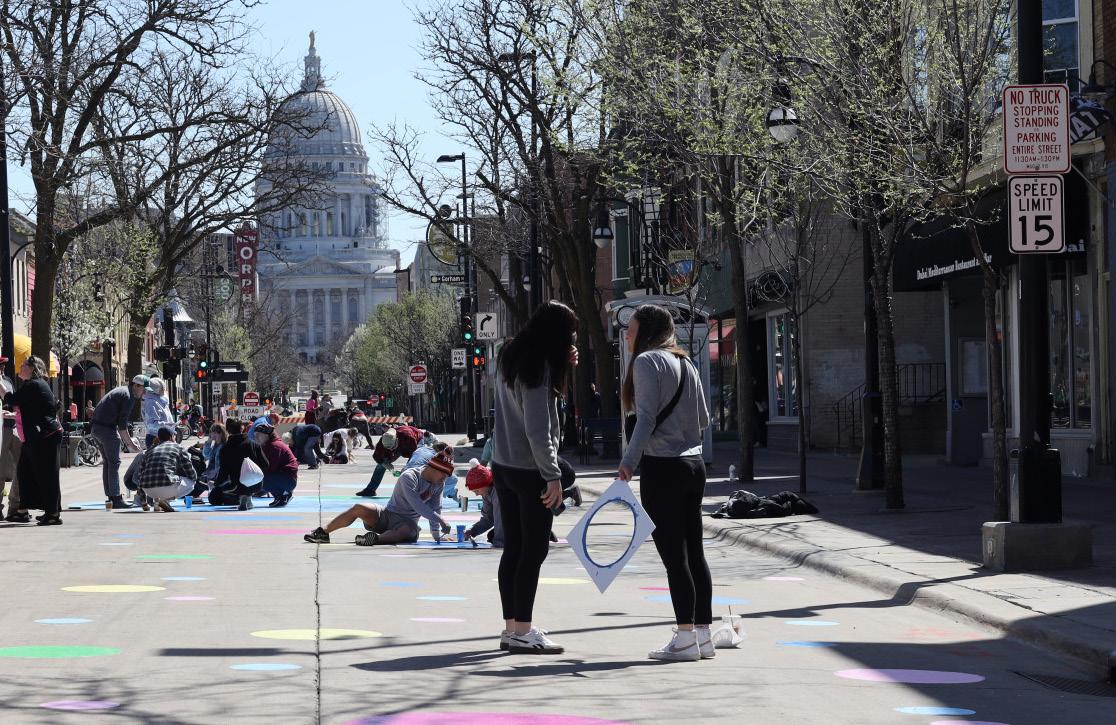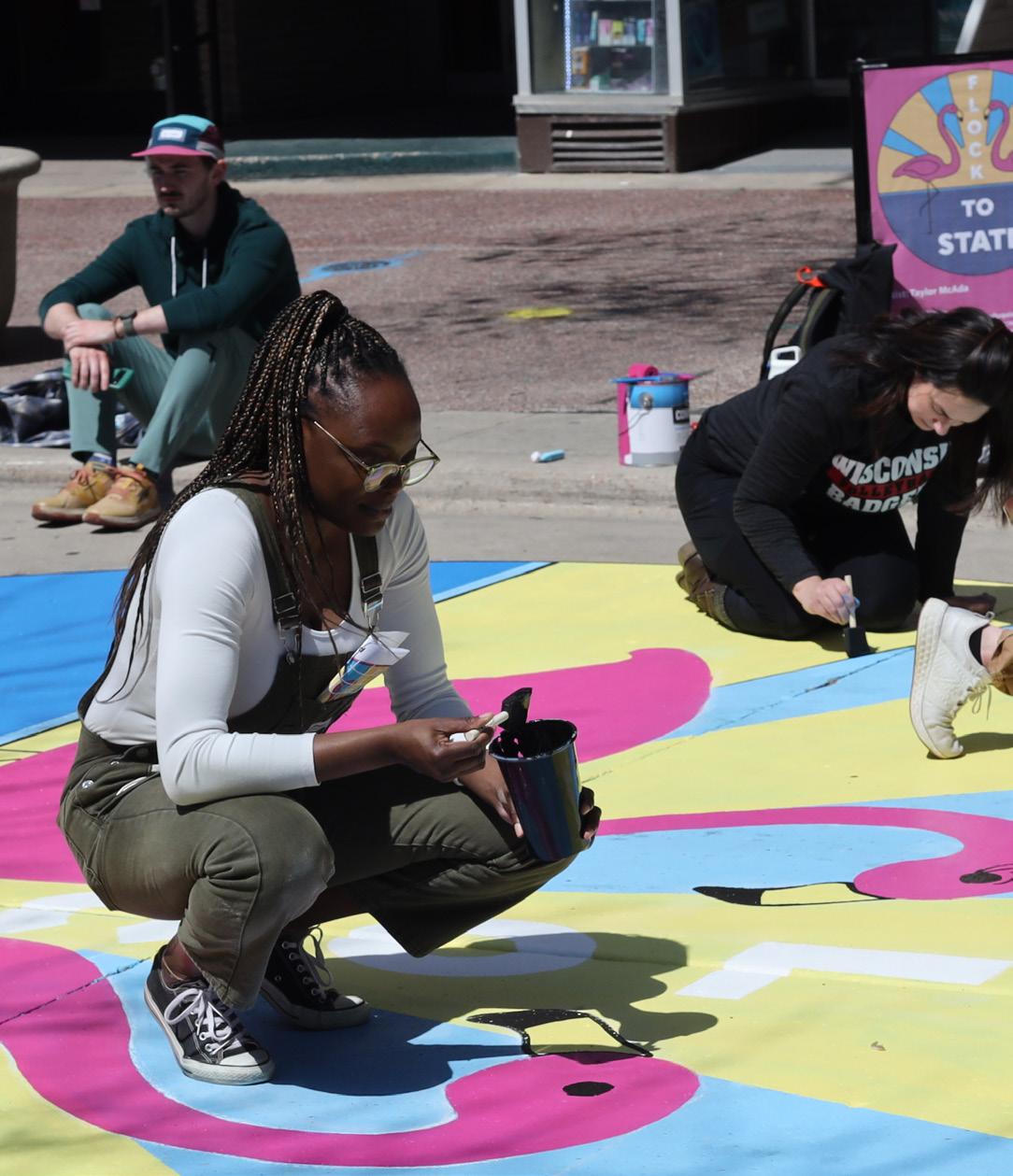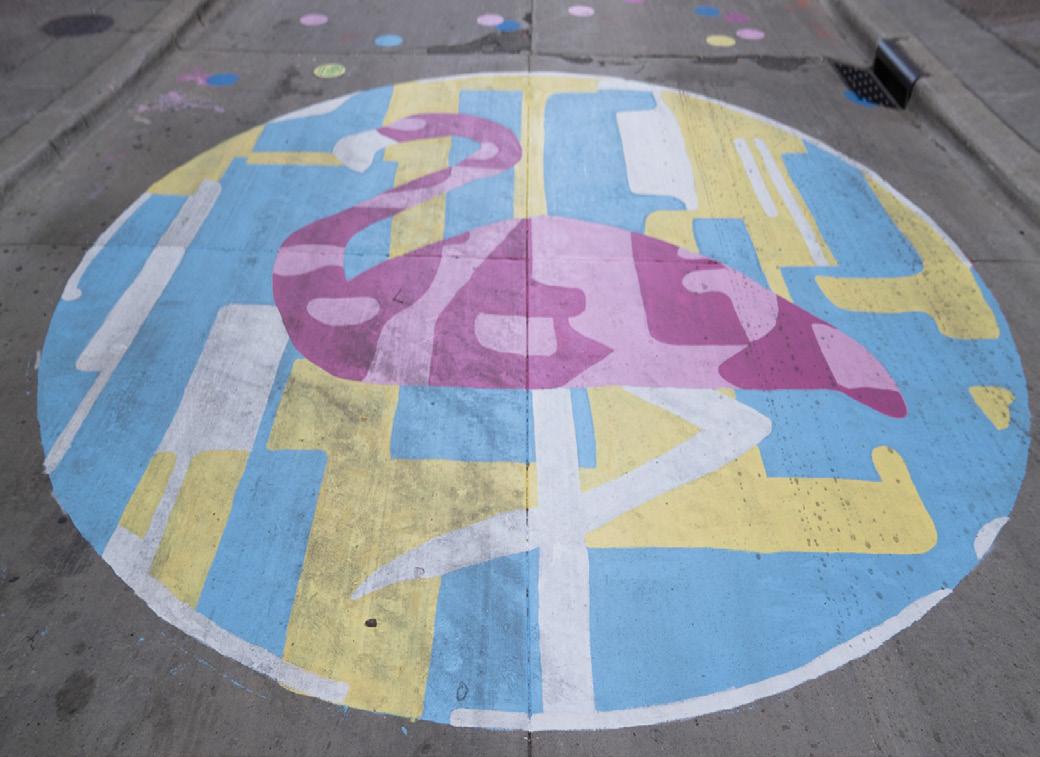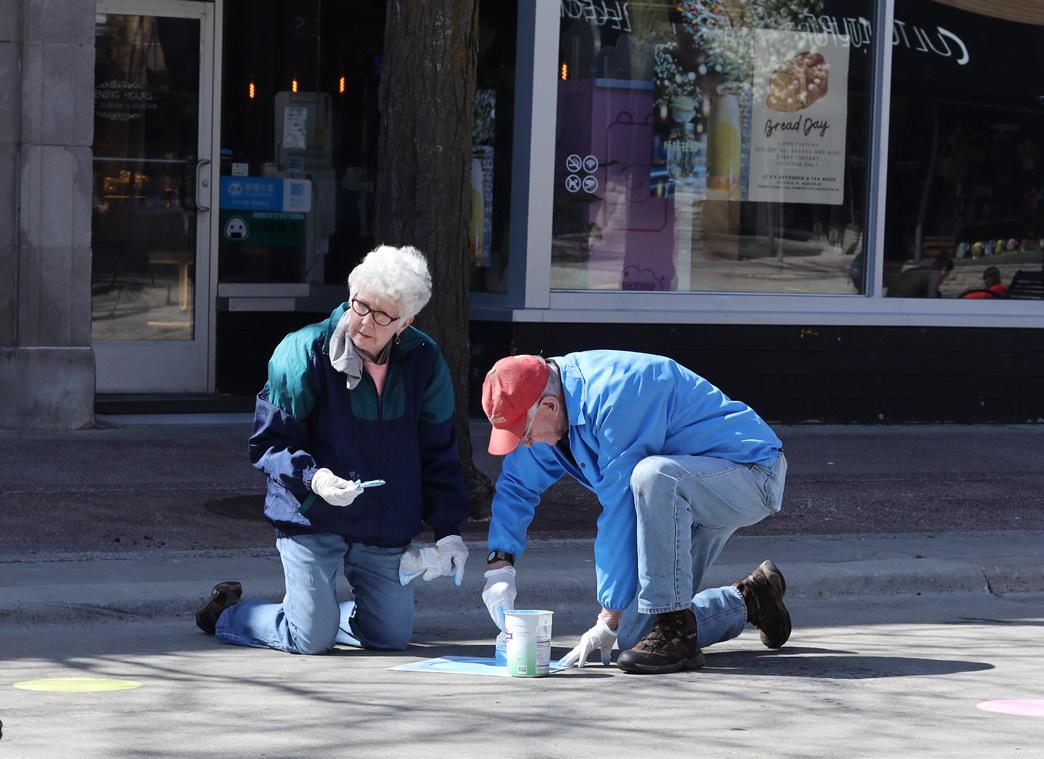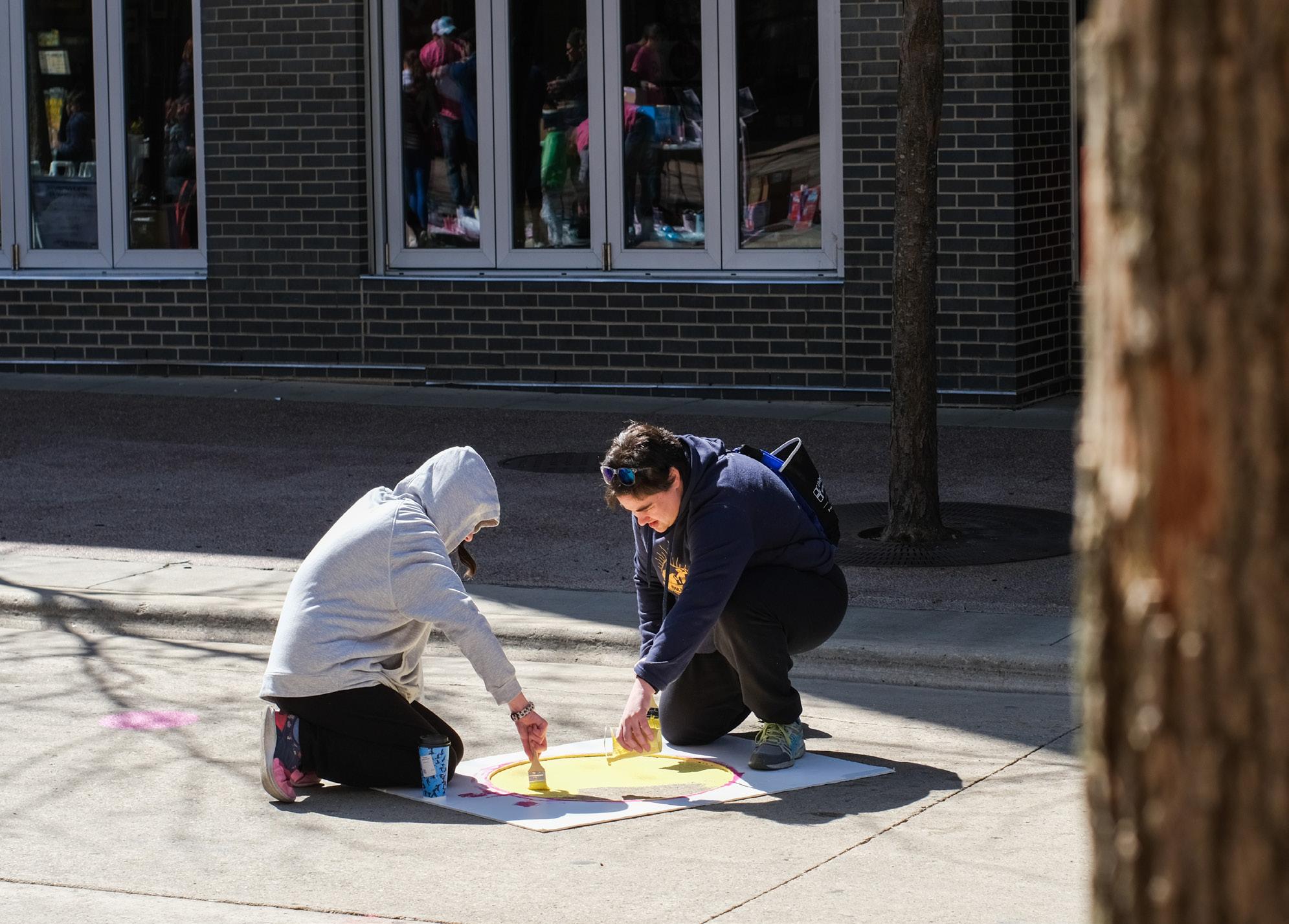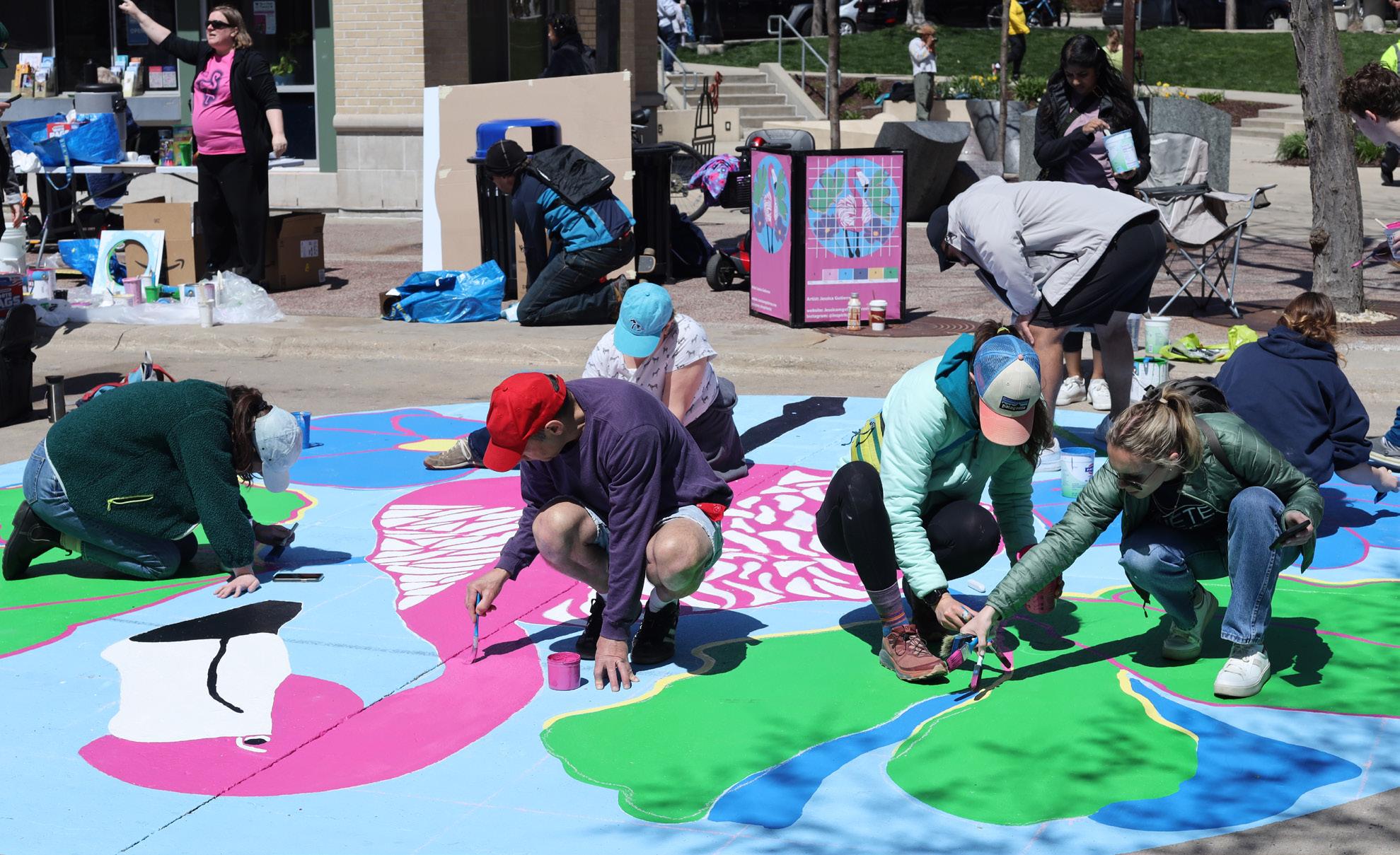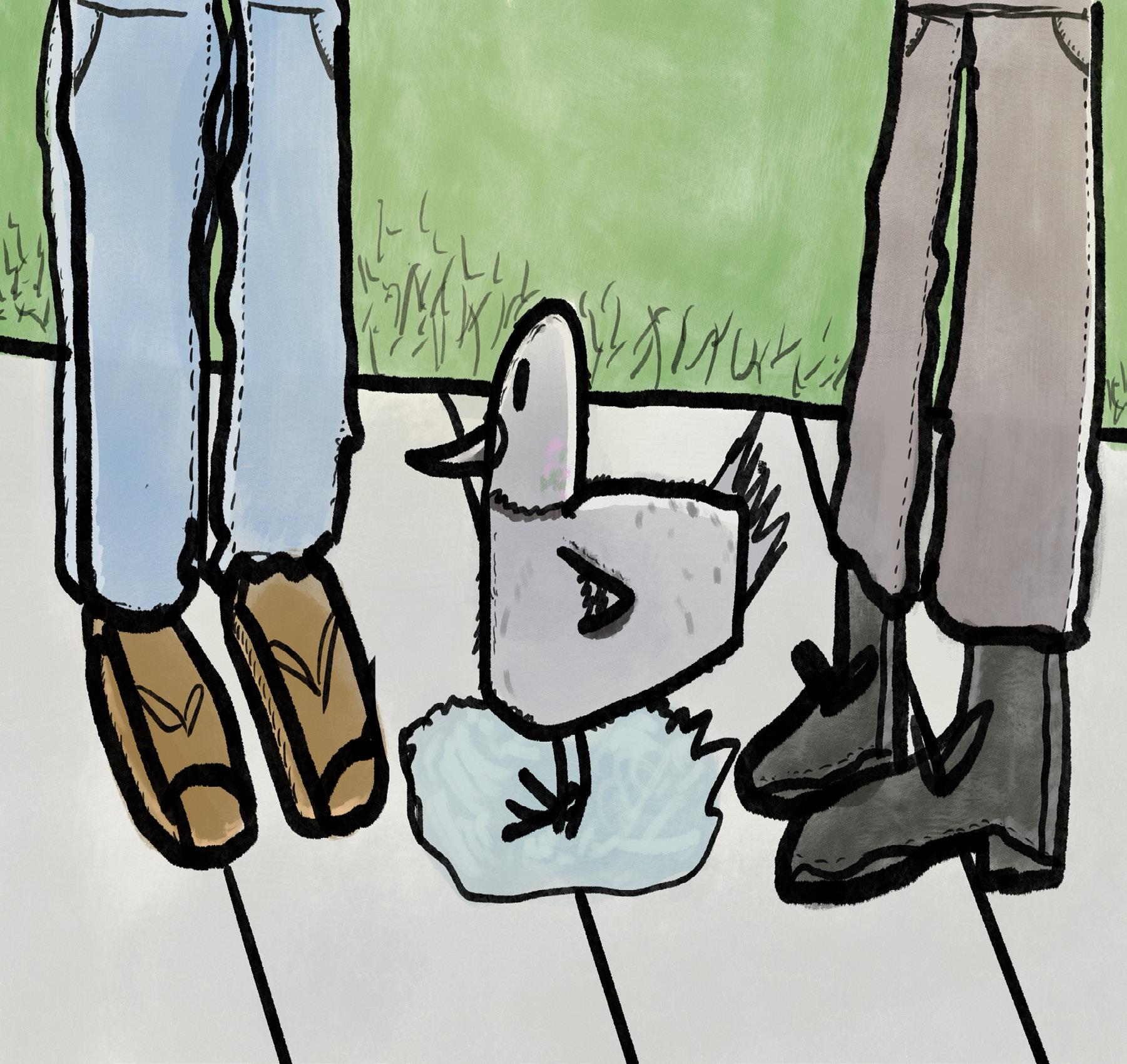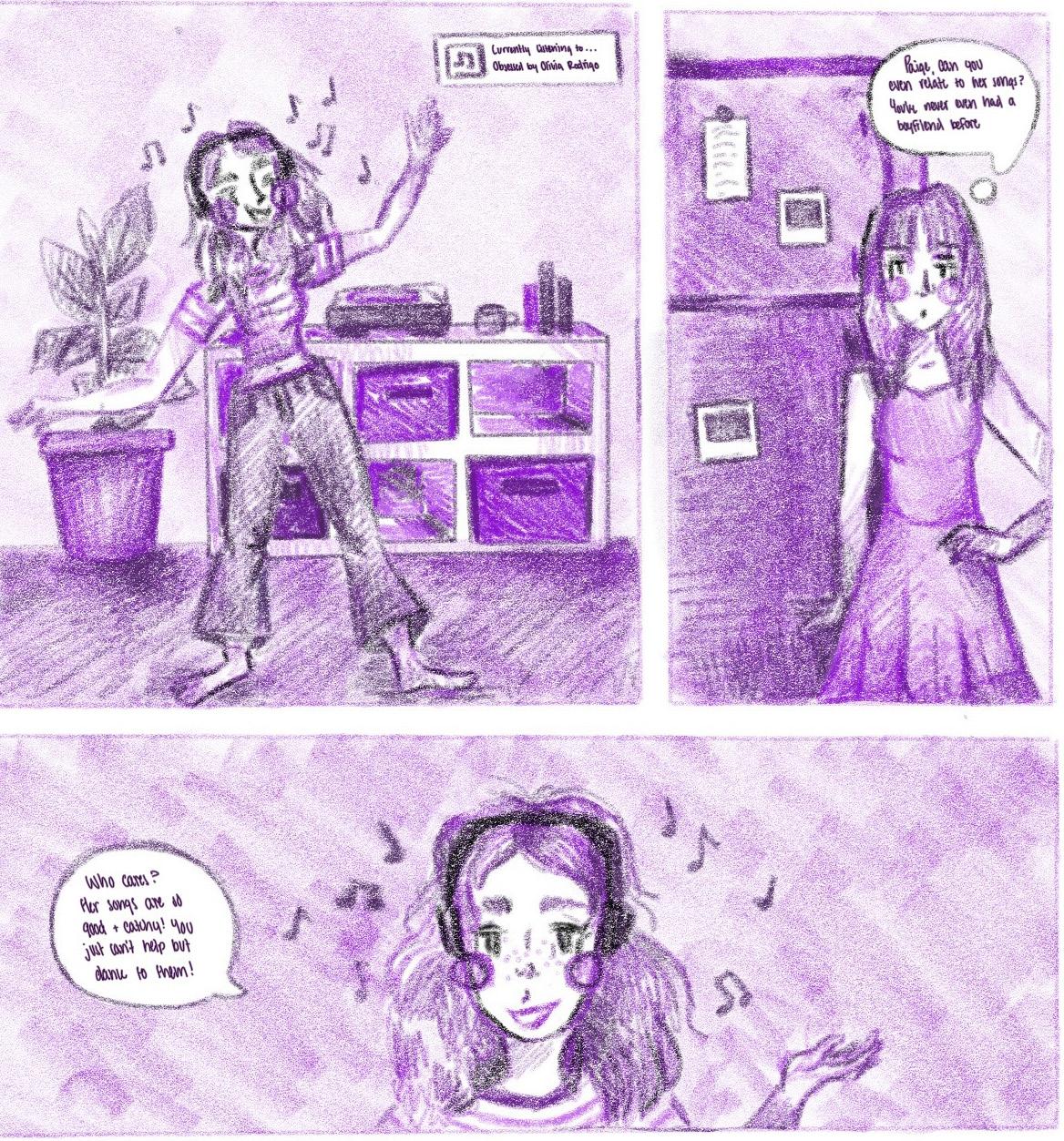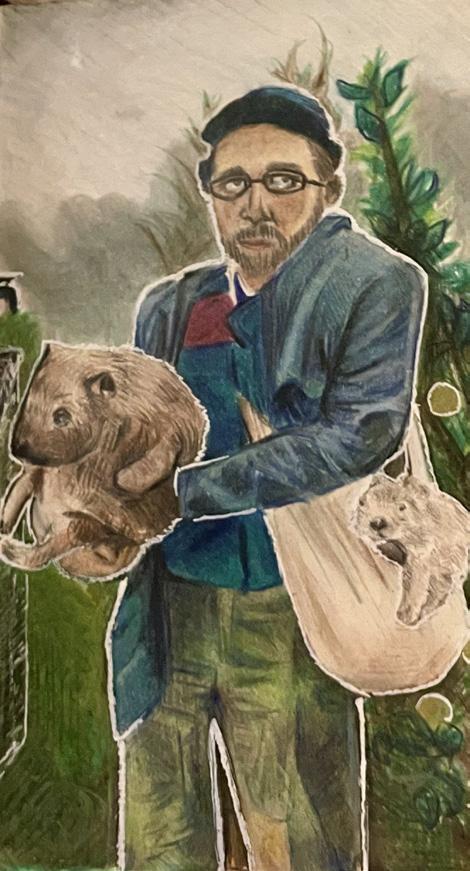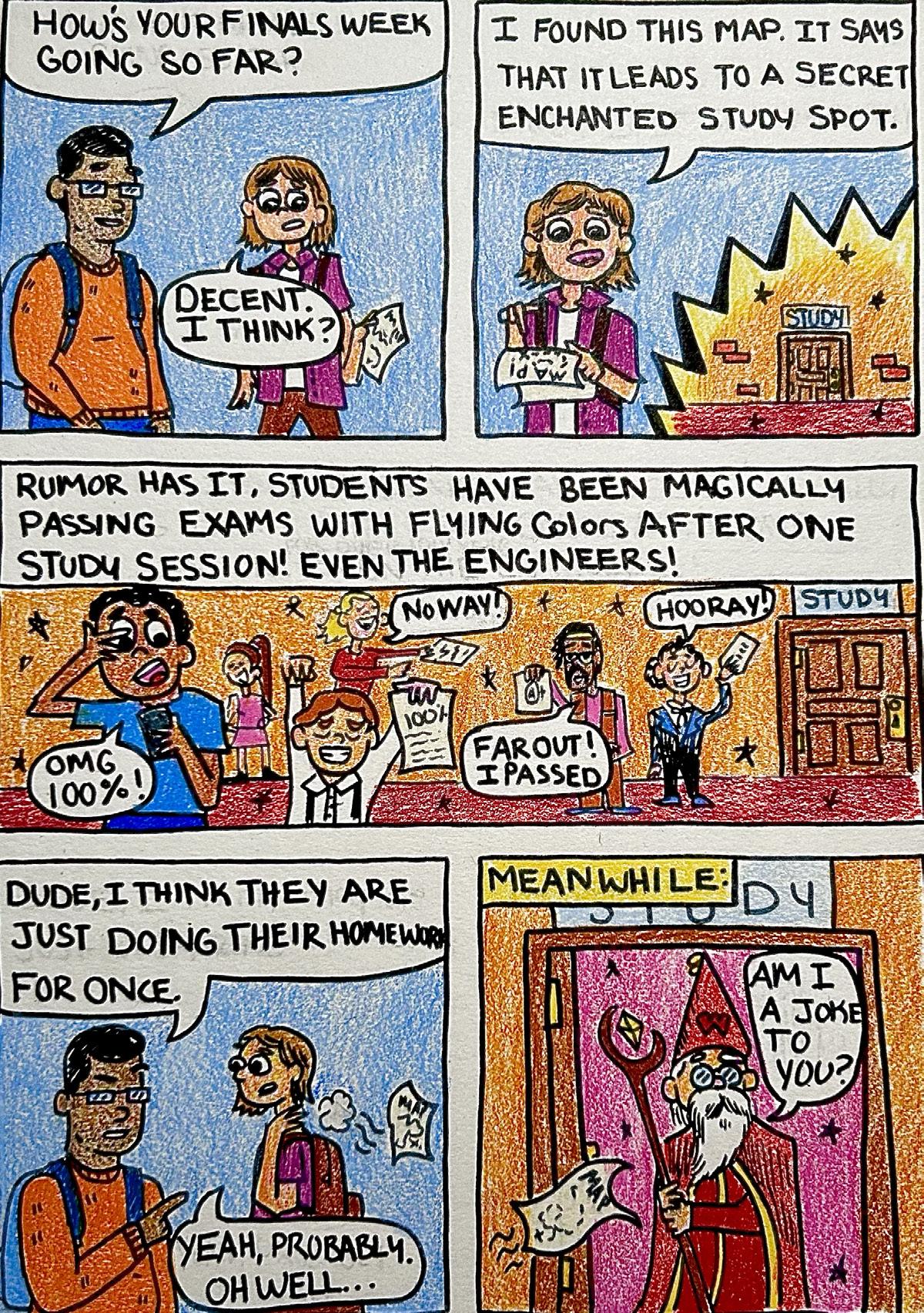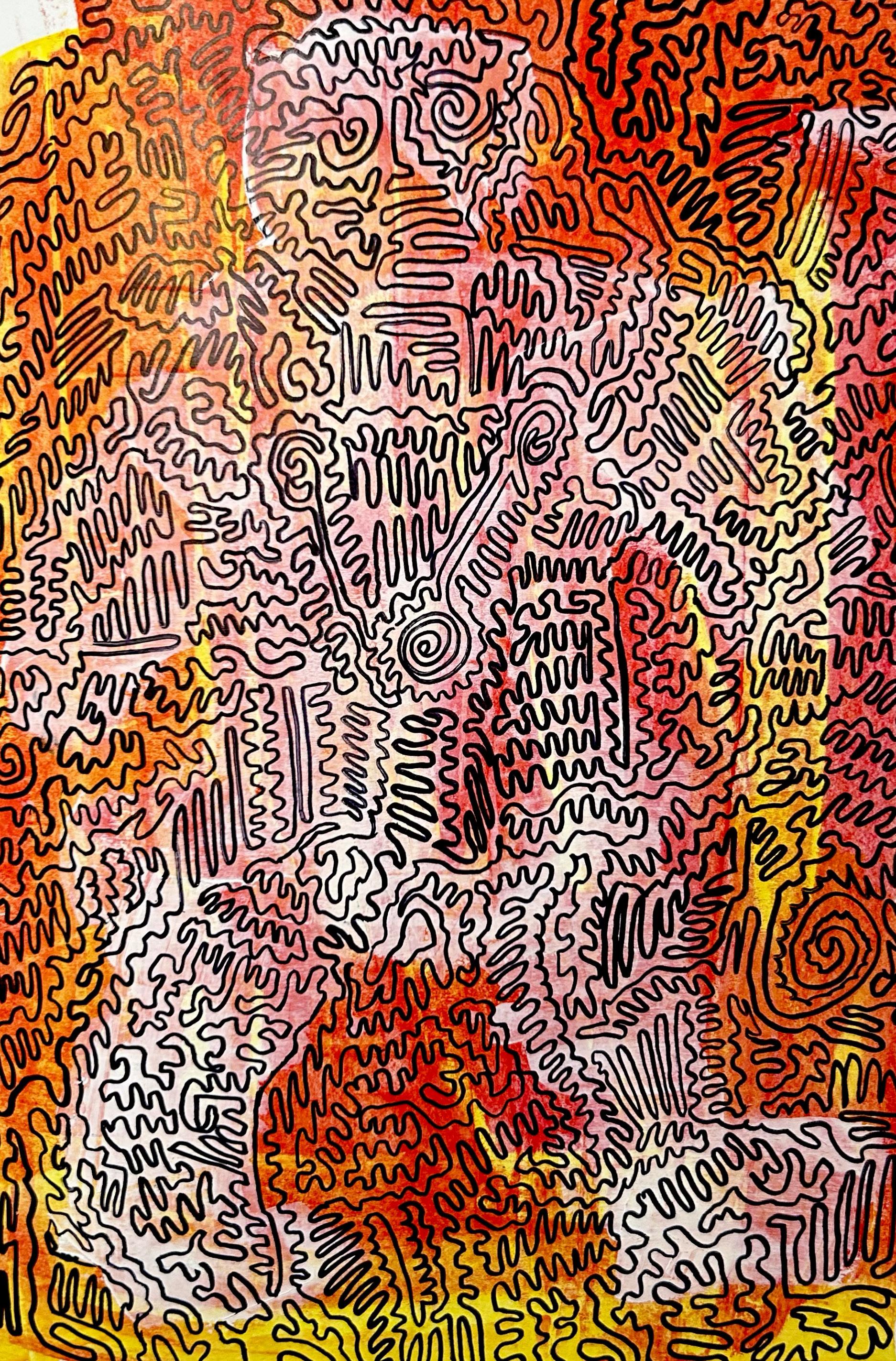






The summer of 2023 feels like eons past, yet it was only nine short months ago that we began our year at the University of Wisconsin-Madison.
For some, it was the beginning of our college journeys.
For others, it was the final year before we took our first steps into our careers. And everyone else found themselves somewhere in between.
This year was a trip. From the war in Gaza, to battles between the UW System and
the Republican-controlled state Legislature over funding diversity, equity and inclusion programs, to struggles over free speech, belonging and safety on campus, the past few months were marred by forces and conflicts which, at times, felt well outside our control.
But within it all, we found something valuable: the importance of community and the bonds we share as UW-Madison students.
We also learned to be (marginally) better at taking care of ourselves in times of struggle. It’s more important than ever
to check in with your friends, family and loved ones. And it’s even more important to check in with yourself. When you’re struggling, don’t hesitate to take some time for yourself or check in with a mental health specialist. (That includes you, fellow reporters!)
If you’re ever feeling alone on campus, or if you’re overwhelmed and don’t know where to turn, remind yourself that there are thousands of other students in your shoes. UW-Madison is a place with hundreds of communities that you can call home,
and your fellow students are more than happy to welcome you and call you a friend.
And if there aren’t institutions, campus centers, student groups or community organizations that feel like home to you, don’t be afraid to make one. Seek out people in a similar situation, people with similar backgrounds, people with similar interests and people with similar struggles. Take it upon yourself to be the light shining in darkness for those around you.
And above all, remember that you’re not alone.
Mnookin discussed major accomplishments in her second year as chancellor, including establishing the Wisconsin Research, Innovation and Scholarly Excellence (RISE) program, a targeted hiring initiative in six areas including artificial intelligence and sustainability. She also announced six weeks of paid family leave for university employees earlier this month.
Mnookin and Reesor answered questions from student journalists on the university’s commitment to diversity, equity and inclusion, their partnerships with the Associated Students of Madison and spaces for marginalized students on campus.
Campus protests, freedom of speech
In response to protests across campus over the war in Gaza and frustration over the university’s current protest policy, Mnookin voiced her support of students’ right to assemble and utilize their freedom of speech, so long as those actions “stay within permissible limits and rules.”
“It’s really important as a public university that we o er spaces for free expression while balancing safety and security,” she said.
In light of pro-Palestine protests at college campuses across the country, Mnookin clarified UW System Guidelines prohibit any person from picnicking or camping “on university lands, except in those areas specifically designated,” under UWS 18.07(04).
Reesor said the university plans to increase the amount of clear information and resources available to students online about protesting rights. She also mentioned the new mandatory “free expression” module, a new training program for students required as part of a controversial December deal between the UW System Board of Regents and Republican state lawmakers.
Sustainability goals, achievements
Mnookin discussed the recently announced RISE-EARTH, a new research hub for sustainability on campus, and her February 2024 commitment to five sustainability goals. She highlighted ASM Sustainability Committee’s collaboration to develop these policies.
“For the first time, we are having clearly defined goals for our campus, for global energies, zero emissions, zero waste,” Mnookin said. “This was the product of so many people’s work, of a lot of engagement by a lot of people, including shared governance.”
Christina Treacy, ASM Sustainability Chair, told The Daily
Cardinal in February that ASM was “excited that the university is actually taking institutional action on sustainability.”
However, Treacy said ASM Sustainability was “discourag[ed] to see that our further feedback was not necessarily implemented” in regards to certain sustainability goals and making a sustainability academic requirement.
Campus cultural centers
Demands for a physical space on campus for Middle Eastern and North African (MENA) students have been circulating around campus, most recently in the form of a petition created by ASM intern Haia Al Zein. As of Wednesday, the petition has more than 300 signatures.
“We’ve had tremendous success with the MENA heritage months, and certainly that is a growing population of students who are searching for community and belonging. We want to and will continue to support that work,” Reesor said. “I think the question is, is the center also the right way to do that, or are there other ways to support our students?”
Currently, the Multicultural Student Center (MSC) oversees four identity centers: the Asian Pacific Islander Desi American Student Center, the Black Cultural Center, the Indigenous Student Center and the Latinx Cultural Center. The McBurney Disability Center also has a Disability Cultural Center.
Reesor said other student groups on campus are inter -

ested in permanent gathering spaces, including Mecha de UW-Madison, a Latine student organization that was temporarily relocated to the Red Gym because of Levy Hall’s construction, and the Indigenous Student Center, an organization whose building is threatened by possible Levy Hall expansion.
Other groups with an interest in campus space include veterans, firstgen students and students in recovery.
With many groups looking for support, Reesor said it can be di cult to decide “how many [centers] we will have and who decides [them].”
Student A airs leadership has met with consultants and hosted listening sessions to obtain feedback on the use of student spaces on campus, Reesor added.
Campus e orts to support mental, spiritual well-being
Reesor highlighted advancements in mental health resources and availability, including a 40% reduction in wait times for University Health Services mental health appointments over the last two years.
She announced additional mental health counselors will become available in the Red Gym and the McBurney Disability Cultural Center next fall to support students in those spaces.
Apart from mental health professionals, the university is looking to hire peer educators to assist in educating students with historically limited access to healthcare and healthcare information because of a grant from the American College Health Foundation.
“We know from research the power of peer mentors, that you all listen to each other far more than anybody else,” Reesor said.
Reesor also mentioned an increase of outreach and support for students celebrating non-Christian holidays o ered by the Center for Interfaith Dialogue. Support measures include providing students with language to speak with instructors about missing class for holidays as well as directly educating instructors on the importance of these holidays.
“This year specifically, but certainly not limited, it’s been very focused on our Jewish students and our Muslim students,” Reesor said. “It shouldn’t always have to be the burden of religious students to have to do that education and explanation.”
Being surrounded by people in loud auditoriums makes attending lectures di cult for Amanda.
Amanda, a freshman at the University of Wisconsin-Madison whom The Daily Cardinal is identifying by a pseudonym due to privacy concerns, is sensitive to noise and touch, making lectures and exams di cult.
“Going to large lectures or having exams in large lecture halls is a nightmare for me,” Amanda said. “It’s a lot of closed spaces, small sounds and tight-knit quarters with people brushing me, being close to me, and it’s really distracting. It makes it hard for me to type and focus.”
There are 99 UW-Madison students on the autism spectrum, according to the McBurney Disability Resource Center’s 2022-23 annual report. But because the report counts only primary diagnoses — and because some students don’t utilize the McBurney Center — the actual number is likely much higher than that, according to McBurney Center Access Consultant Heather Stelljes.
“There are many people who identify as having a disability or being disabled that are not registered through our o ce because they don’t need accommodations,” Stelljes said. “My hunch would be the same for autistic students as well.”
Amanda is one such student
who chose not to register with the McBurney Center.
“I’m also diagnosed with anxiety and depression, and I didn’t really want Madison to know about that,” Amanda said. “I’m also not sure if it would help my specific issues.”
Beyond difficulties with large lectures, Amanda said she struggles with small group discussions and group work, calling them “incredibly uncomfortable.”
“I don’t like to make eye contact,” she said. “I recognize I’m pretty awkward with new people, so I usually don’t participate.”
Amanda said she has anxiety about going to class, which impacts her understanding of course material, and she struggles to find places to study.
“I definitely struggle to study surrounded by people,” she said. “I’m so scared to make any noise, but then when people make noise it’s so stressful and I can’t focus at all. I usually go back to my dorm.”
But with construction ongoing at her dorm, Amanda said she feels like she can’t go back to her room either. And with the constant noise, it’s a long process for her to feel comfortable studying.
“It’s either going back to my dorm, a study room or gender neutral bathroom or just somewhere where I can be alone and quiet and know that no one’s going to see me,
like, ticing,” Amanda said.
Tics are actions common in autistic people resembling “patterned normal movements, but appearing repetitively, often with exaggerated intensity and increased frequency,” according to a study conducted at University Medical Center Hamburg-Eppendorf.
For Amanda, this can be anything from clicking in the back of her throat to raspy breathing or full body shivers. But to be comfortable, she said she needs a place to “unmask.”
“I have to look for one of the very few spaces where I can be alone somewhere where someone isn’t waiting in line for me to be done,” she said.
What is autism?
Autism spectrum disorder a ects an estimated 1 in 36 adults and 1 in 45 children, according to the CDC, and refers to a “broad range of conditions characterized by challenges with social skills, repetitive behaviors, speech and nonverbal communication.” April marks Autism Acceptance Month, which aims to raise public awareness of the condition and celebrate neurodiversity.
The condition may be directly related to the areas of the brainstem — a “stalk-like” structure located at the base of the brain — involved in autonomic functions, according to research from Brittany Travers, a Waisman Center investigator and professor of kinesiology.
“The brainstem is one of the earliest developing parts of the brain. So, it makes sense in a neurodevelopmental condition like autism that there would be di erences that are happening in the brainstem that help explain the individual di erences in autism,” Travers said in a press release.
Autism has increased over the last two decades, Director of the University Center for Excellence In Developmental Disabilities at the Waisman Center Leann DaWalt told the Cardinal. This is likely a combination of higher diagnosis percentages and more overall autistic people, she said.
As the name suggests, autism is a spectrum condition, with over 100 genes being suspected of playing a role in the condition, according to a press release from the Waisman Center.
“No autistic child is the same,” DaWalt said. “There are individual di erences.”
As such, assigning global accommodations for autistic students is not enough. Stelljes said accommodations for autistic students would depend on “personal experience” and specific needs.
“There might be accommodations around extra time with testing, smaller group testing or testing alone,” Stelljes said. “There may be some accommodations around note-taking. It depends on how a student really thrives in di erent settings.”
The Waisman Center’s research
backs up this sentiment.
“Everybody is di erent. I think that’s a truism that works across the life course,” DaWalt said. “Our research has shown that a lot of autistic adults as they move into adulthood, we see a lot of di erence from childhood.”
Still work to do
For Amanda, the hustle and bustle of life as a student can be overwhelming.
She often skips meals at the dining hall with her friends because she “hates” eating in front of people and often gets meals to go. She said she’s noticed weight loss as a result.
“I’m definitely eating a lot less,” Amanda said. “Not because I’m not hungry, but just because I am scared and anxious.”
But Amanda said she wants her friends to understand she’s okay.
“I want them to understand how hard it is as an autistic person to do the things that they can do without a second thought. And to not assume I’m mad at them,” Amanda said. “But [to] just understand autism a little bit more, especially in a collegiate setting, and realize how hard it is for me to even go to the dining hall with them or go get on the bus to go see them.”
Amanda said she thinks there’s still a lot of work left to do to get autism awareness and accommodations to where they need to be.
Continuereadingatdailycardinal.com
The Associated Students of Madison, UW-Madison’s student government body, passed legislation to reform a joint campus police oversight committee after ignoring communications from the police department.
Landis Varughese, ASM antiviolence chair and PAC member, introduced the legislation after the UW-Madison Police Advisory Committee did not meet for approximately six months. The committee’s last meeting was in October 2023.
The committee is composed of faculty, administrative sta and student representatives who “share relevant feedback with UWPD sta , and o er perspectives about various aspects of the department’s operations,” according to the committee website.
The legislation, titled “Reimagining UWPD Advisory Council” was passed unanimously and called for reinstatement of committee meetings in August, more accessible meeting times and locations, and a greater number of student representation on the committee.
“When you talk about the functions of UWPD, their goal is to serve students and they also didn’t have students at the table [during recent campus events],” Varughese said. “I feel like there needs to be student input and students involved in this kind of discourse.”
Varughese said committee meetings, which usually take place on the last Wednesday of each month, were canceled without any explanation from UWPD until March 13
when Rachel Laubmeier, executive assistant to the chiefs, indicated meetings would be “canceled for the foreseeable future.”
In a follow-up to an inquiry from a committee member, Laubmeier said UWPD was taking former UWPD Police Chief Kristen Roman’s abrupt resignation in February as an “opportunity to face inward and heal the department.”
According to WMTV, an internal investigation of a possible violation of university policy by an employee believed to be Roman was completed as of early April. It’s currently unclear when the investigation results will be public.
Varughese was concerned about how student input would be solicited in the search for the next UWPD chief, given the committee has not met in months.
In a statement to The Daily Cardinal, UWPD spokesperson Marc Lovicott said UWPD was disappointed that ASM passed the legislation without the department’s input.
“We have since sent a letter to ASM leadership and the legislation co-sponsors to share our concerns about the legislation and once again request a meeting so we can move forward and work together to make campus a safe and enjoyable place for everyone,” Lovicott said.
Lovicott also said holiday schedules and breaks were the primary reason for meeting cancellations in November, December and January. Varughese, the ASM representative, said the meetings were canceled without explanation.
Additionally, Lovicott said UWPD interim Chief Brent Plisch met with ASM leaders on Feb. 21, during which ASM leaders said they would follow-up on options for future engagement. ASM never followed up, Lovicott said.
Varughese said he did not recall the February meeting requiring follow-up and said the meeting primarily focused on the Feb. 13 shoving of a protester by a UWPD o cer, not the oversight committee.
“This meeting had just taken place shortly after the engineering career fair incident. Some leaders were looking for clarification on that,” Varughese said. “And it was very interesting because Interim Chief Plisch did bring up [the committee] when asked about ways UWPD is engaging with students, but did not recognize the fact that it wasn’t active until another student from ASM said so. He was bringing it up as a form of recourse [that exists].”
Lovicott also said Plisch followed up with ASM leaders on March 15 asking to schedule another meeting. ASM Chair Kevin Jacobson confirmed he received the email and did not respond. Varughese did not receive the email.
“It’s good to work in collaboration with the administration, but it’s not something we always do. And I would say that it’s also important that we bring policies, especially those that are really complex like this, before our primary governing body, which is the Student Council,” Jacobson said.
In an email to ASM leaders
Monday, Plisch criticized the leaders for not replying to his requests and failing to collaborate with UWPD on the legislation.
“This legislation, with no participation, feedback, insight, or partnership from the organization most impacted, provides words with no action and I fear it is not enough to make the PAC a meaningful group,” Plisch said in an email to ASM leaders.
Plisch also expressed his interest in obtaining student and community feedback for UWPD’s search for the next chief.
“Action is required now if the PAC wants to play a meaningful role in the selection of the new Chief of Police,” Plisch said in an email to ASM leaders. “However, what we were doing previously, which
includes some of the suggestions in the legislation, was not working to have meaningful participation and must be carefully and thoughtfully reimagined, not as an unenforceable demand or a mandate, but through partnership and collaboration.” Jacobson confirmed he responded to the most recent email from Plisch and indicated that his term as chair ended Wednesday, which means the new chair will be responsible for partnering with UWPD to reestablish avenues for community oversight and student engagement with campus police.
“The whole intention of legislation was not necessarily a condemnation of UWPD, but rather an invitation,” Varughese said. “I do hope that, in the future, ASM leadership makes these demands a reality.”

Memorial Union Terrace sea-
son has arrived for University of Wisconsin-Madison students. And while some students will be going back home or jetting o to a new destination there is plenty of opportunity to explore the city of Madison for those who stick around.
Shawn MacGregor, a student at the UW-Madison, said he’s excited for Madison’s “best season” to begin.
“Madison is just so beautiful in the summer because all the trees and the flowers are finally blooming and green,” MacGregor said. “And there are, of course, a lot less people on campus. So I think you can really find some hidden treasures.”
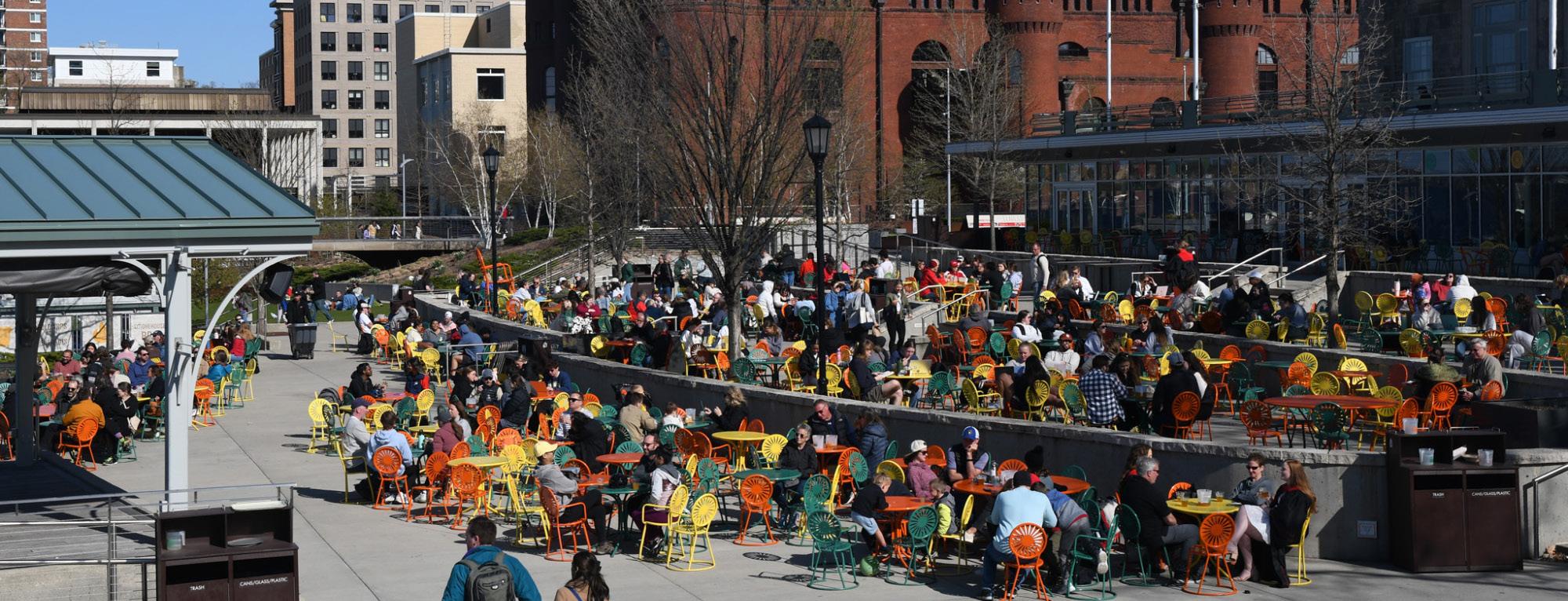
rounded by people a liated with the university,” MacGregor said. “It’s nice to leave campus and see families buy some fresh produce.”
In Madison, there is no shortage of bodies of water with plenty of activities. Nestled between Lake Mendota and Monona, Madison is one of two major United States cities built on an isthmus — a narrow strip of land that connects two larger landmasses and separates two bodies of water.
This summer, UW-Madison student Noelle Glasserenner and her friends plan to take advantage of the waters.
Students will also be excited to spend time in nature and enjoy Madison’s 200 miles of biking and hiking trails. Popular locations include Devil’s Lake and Picnic Point.
“I like hiking. Last year, we went
Dozens of events will be o ered this summer, including film showings, concerts, art projects and outdoor recreation experiences during the Union’s summer festival season beginning in May, according to Shauna Breneman, communications o cer at the Wisconsin Union.
to Picnic Point a couple of times — that was really fun. I think that’s a really popular spot. It’s really pretty, and there are lots of bike paths,” UW-Madison student Abby Mielnick said. “You can bike, rollerblade or skate. I think I will definitely be out in nature. I love to be out, especially here.”
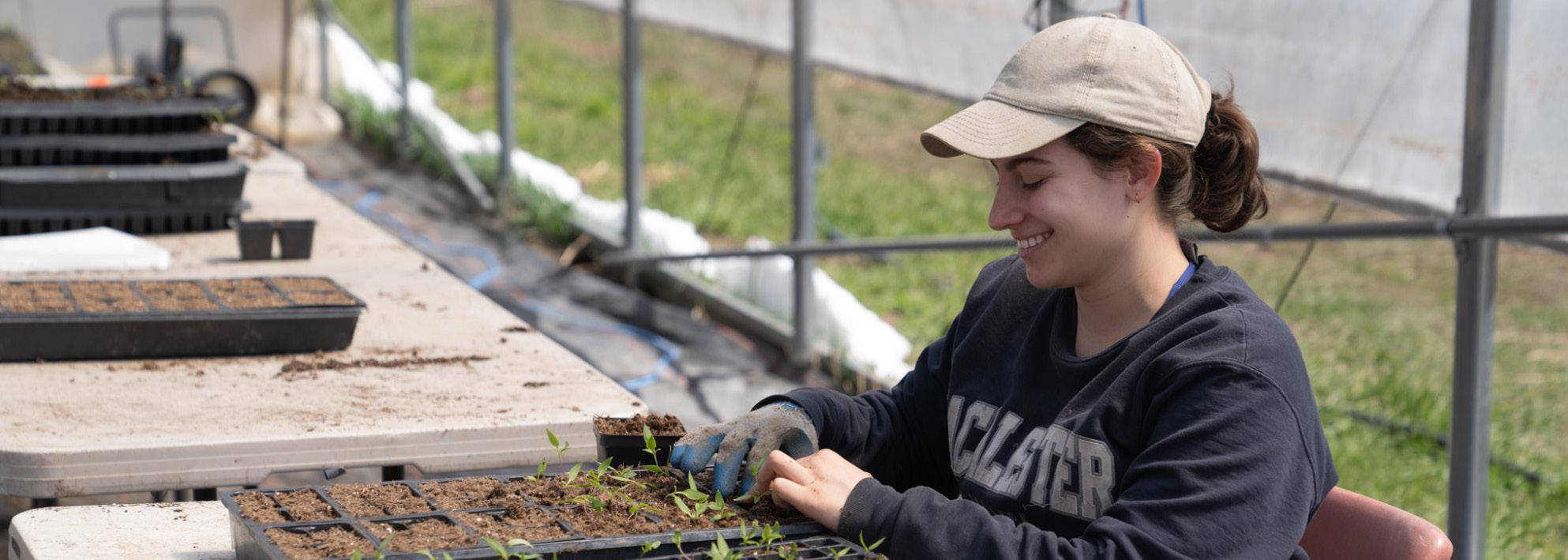 By Ava Menkes STATE NEWS EDITOR
By Ava Menkes STATE NEWS EDITOR
Troy Farm is not the typical acreage of land with a farmhouse or endless rows of crops. Instead, Madison’s oldest urban farm is geared toward youth engagement and food insecurity in the city.
A 26-acre property owned by Madison Area Community Land Trust, Troy Farm is an organic vegetable program that’s been operated by the larger Rooted nonprofit since 2001. The nonprofit raises money to promote agricultural education and deliver weekly to community centers on Madison’s north side from June to October to reduce food shortages, Troy Farm director Paul Huber told The Daily Cardinal.
“With the help of the community center directors, the produce is laid out farmers market style so people can select what they want and in the quantities they want,” Huber said in an email.
Rooted also hosts events at Troy Farm, including a plant sale on May 11 where people can purchase vegetable, fruit and flower pants using their Electronic Benefits Transfer or Supplemental Nutrition Assistance Program funds.
Additionally, people can take advantage of their double dollars program, which provides a bonus of $20 each week when participants buy produce or plants. At other events, Rooted o ers food vouchers to community center residents and pay-what-you-can meals.
Troy Farm also educates the younger generation of growers through their Kids’ Garden programs, which serves Madison Metropolitan School District students, according to Brontë Adamson, Troy Farm kids’ garden manager. Schools, individual teachers, summer camps and community centers can schedule onetime field trips or recurring weekly visits during the April to October growing season.
“It’s really fun. [Kids] get to take home a lot of produce, and they get to eat a lot of good veggies,” Adamson said. “The raspberries are always a hit. They take home collard greens or flowers or herbs for their family. A lot of kids like to bring home mint.”
Huber also said Troy Farm is certified organic. The farm reduces the use of toxic pesticides and tilling, a farming method which breaks up soil by turning it over. Instead, the program encourages crop rotation, a method in which farmers plant crops to protect the soil and replenish nutrients for future plantings.
The farm also composts and applies manure from their chickens, Marshmallow and Olive, as fertilizer, Huber said. Their compost system involves collecting from restaurants around Madison and putting the leftovers with a mix of wood chips in buckets.
In January, the farm ended its community supported agriculture program (CSA) because it became financially and logistically unsustainable,
according to the Cap Times.
“We definitely had a difficult decision that we thought long and hard about,” Huber told the Cardinal.
Huber told the Cap Times that CSA served about 400 people and accounted for 80-90% of the farm’s work. He said seasonal hires that supported the program would be scaled back, opening up half an acre of land for other uses.
Huber told the Cardinal that Troy Farms plans to develop their community engagement process and connect with Northside residents to ensure their services are “on point.”
“It’s very rare to have this kind of space in the middle of the city,” he said. “[We] want to make sure we’re doing it right. That could mean that we bring the CSA back. But we couldn’t really get that kind of feedback and do that full deep dive while running the CSA at the same time.”
In the meantime, Huber praised the farming industry and said it empowers young people to get immersed with it.
“It’s a big deal,” he said. “There’s a lot of di erent things to be involved in or not, but just being informed about [the] kind of di erent challenges we all face from climate change to that kind of decline and participation in agriculture, farming needs support from di erent angles and policy and all that stu .”
“I want to say, just give it a try. It’s great, it’s fun and it’s a great community of people.”
The Dane County Farmers’ Market is also a landmark sunny-day attraction. Open every Saturday morning on Capitol Square until November, it is the largest producer-only farmers market in the country.
“I love the farmers’ market because it o ers a relief from being on campus all the time and being sur-
“We did kayaking last year on Lake Monona, it was really fun,” Glasserenner said. “This year, we’ll probably mostly lay on the docks of Lake Mendota and swim once the water gets warm enough. I really like all the water around here. I like to go on walks, and I just find it really calming.”
The Madison Planning Committee held a community-wide art event Sunday to help prepare for an upcoming pedestrian mall experiment on the 400-600 blocks of State Street after almost seven months of planning.
Madison city planner Dan McAuli e told The Daily Cardinal the city commissioned local artists to design ground murals that represent Madison’s community identity.
“We have four very large 20-foot murals, what we are calling the medallions,” McAuli e said. “Those are designs created by local artists.”
The mall experiment revolves around a flamingo motif. McAuli e said the flamingos are meant to represent the pink flamingos that adorn Bascom Hill each fall.
One of the local artists, Sharon Bjyard, designed a medallion with a flamingo stands at the center. The flamingo is surrounded by art deco inspired designs she said compliment the central design.
Bjyard also incorporated hopscotch within her stencil design.
Bjyard said she wanted her medallion to promote “unintentional moments of fun, community and exercise.”
“When I heard it was going to be a ground mural, my first thought was what can you do on the ground that you can’t do on a wall, so hopscotch!” Bjyard said.
In addition to the commissioned artists, over 600 volunteers signed up to participate in the event, according to McAuli e. Volunteers signed up to help paint the medallions and stencil in colorful designs to fill the entire street.
The stencils evoke the lakes that surround Madison, the arboretum, the University of Wisconsin-Madison campus and the flamingo motif.
UW-Madison student and District 8 Ald. MGR Govindarajan said the stencils were a way to communicate
the Madison community with others.
“As you’re sitting in these restaurants and eating your food or having your drinks, you’re going to see all the paintings on the ground,” Govindarajan said. “We are going to have such a variety in what people draw that it communicates what our community cares about in the first place.”
Many volunteers shared this excitement for the growth of the community. One volunteer said she has loved participating in these types of events since moving to Madison from a small town in Michigan’s upper peninsula.
“There’s more activity in a small town, so I love that that’s still here, and we have all the resources and the funding that you have in a larger city,” she said.
A planning sta member working at a painting station said “the hope is people have fun.”
“It’s gonna be potentially chaos, but good chaos,” the sta member said.
Bjyrd commented on the comradery of the volunteer event.
“I feel like it’s already starting, the community aspect of it, and now having people help with the murals gives them a sense of ownership over these projects,” Bjyrd said.
This sense of ownership resonated with some volunteers. One said she is excited to walk around State Street with her friends and family and point out what she helped paint.
McAuli e told the Cardinal the mall experiment will be halfway done in the next few weeks, and the project will finish by May 8. Once the painting is complete and the furniture is in, the street will look completely different, he said.
Govindarajan said he hopes the pedestrian mall becomes “one of those third places where we can meet up with friends.”
“We can just enjoy what Madison has to o er without as many obstacles,” Govindarajan said.
The county’s sole newspaper, the Superior Telegram, struggles to cover local issues.
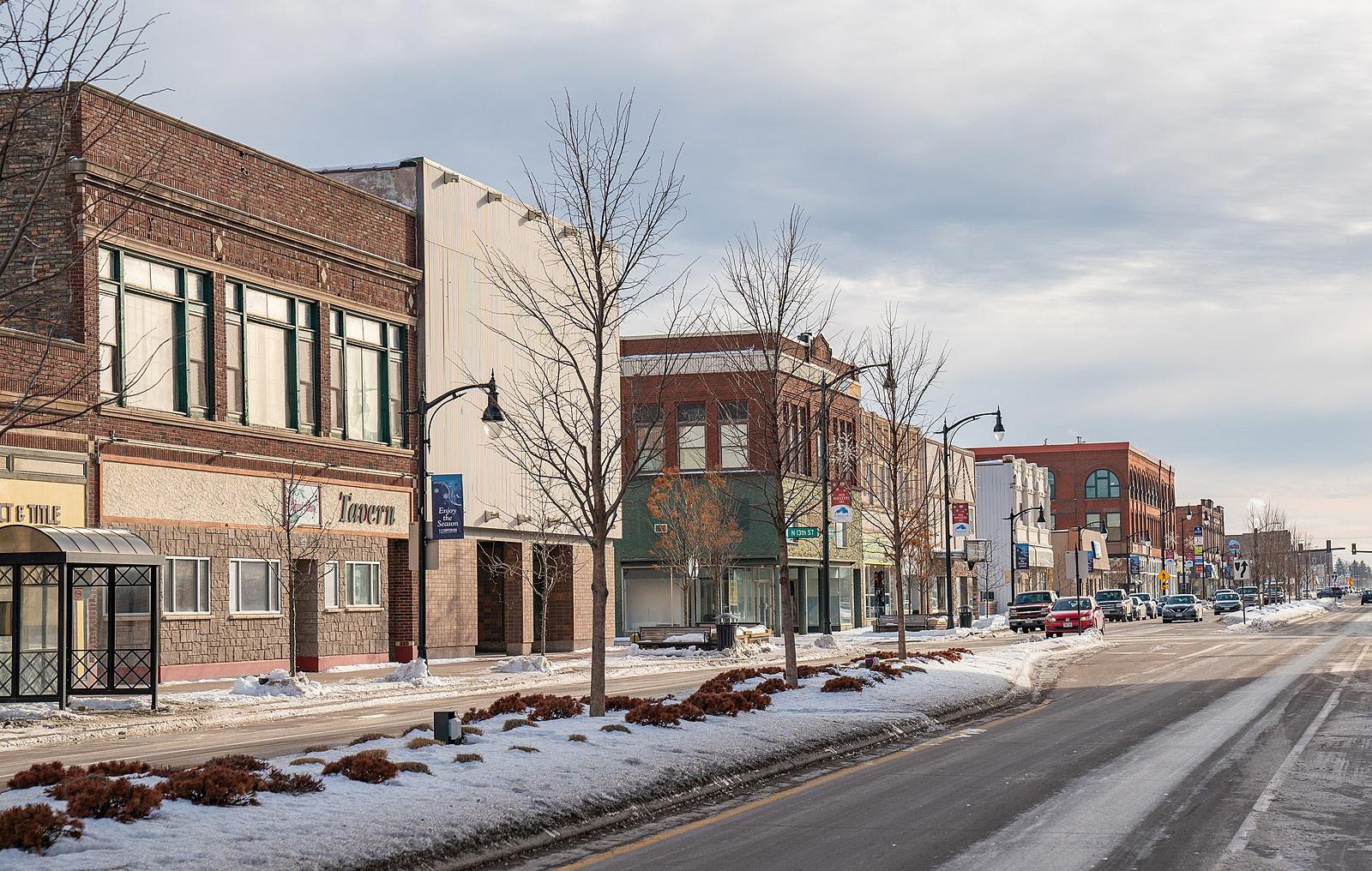 By Joseph Panzer STAFF WRITER
By Joseph Panzer STAFF WRITER
Shannon Johnson, owner of Shannon’s Stained Glassery in Superior, Wisconsin, said she has struggled to stay informed on local news in Douglas County.
Johnson tries to read the local newspaper, the Superior Telegram, but that presents challenges that drive her to seek her news from other sources.
“You have to pay to see any articles, so I look at headlines but not a ton of articles,” Johnson told The Daily Cardinal. “Television sites like WDIO or Fox are typically where I’ll go.”
Social media sites like Facebook act as a platform for residents to get information online. But they present another challenge: they’re often unvetted echo chambers.
As echo chambers grow online, their potential to influence politics increases, according to research from the University of Pennsylvania that measured the impact echo chambers on sites like Facebook had on the 2020 election.
“Any community that loses its independent media and variety of sources of information is susceptible to echo chambers,” Meg Turville-Heitz, project director for the Beyond the Headlines investigation of the Douglas County news desert at the Wisconsin Humanities Council, told the Cardinal in an email.
Douglas County’s barren media landscape
The Wisconsin-Minnesota border community of Douglas County encompasses the towns of Superior and Solon Springs and has a population of 44,144, according to the U.S. Census Bureau.
Despite its proximity to Duluth, the county is considered a news desert, defined by the University of San Francisco as a community covered by one or zero newspapers.
The county’s sole newspaper, the Superior Telegram, has struggled in recent times.
“There are only two of us reporters, so obviously we can’t cover everything,” Telegram
reporter Maria Lockwood told the Cardinal.
For Lockwood, a “big selling point” of a career in journalism as a mother of four children under the age of nine was the speed at which she could get a journalism degree when she went back to college after taking 10 years o to raise a family.
“I had no idea how much I would love this job,” Lockwood said. ”I enjoy research and learning new things. I have an insatiable curiosity and care about the community.”
The Telegram had a full newsroom when Lockwood started in 1999. But the number of employees dropped significantly in 2010.
“Our printing press [shut] down one to two years later, and our sta continually [dwindled] until we began operating with our current team around late 2018,” Lockwood said.
According to the Library of Congress, the Superior Telegram has been Superior’s only local newspaper for more than three decades since the town’s other paper, The Chronicle, ceased publication in 1987 after only three years on the market.
Due to its small sta size and challenges brought to local news outlets by the COVID-19 pandemic, the Telegram started printing only one paper per week in 2020. They had previously been printing twice weekly since 2008 instead of their traditional six-day-a-week model.
In an email, Lockwood added that the Telegram’s news team consists only of herself, fellow reporter Shelly Nelson, a photographer and a paginator, someone who divides a document into pages.
“We’re still here, which I count that as a win, because that’s a win for everyone because there’s still a paper here covering everything they need to know,” Lockwood said.
As of February, the Telegram has approximately 2,591 subscribers, 1,518 of which are print
subscriptions while the remaining 1,073 are digital subscriptions, according to an email from Lockwood. This means only 5.9% of Douglas County residents are subscribed to the Telegram.
“We want to let [readers] know what’s going on in their community,” Lockwood said. “We want to give them the information and the resources so they can go out and find out more about what’s going on next door, what’s going on down the street and how they can be involved.”
Resident of Douglas County left isolated
Without a substantial local news presence in Douglas County, residents like Johnson, the Superior Stained Glassery owner, are left to get news and information about their community from social media and other alternative sources.
“I have four kids, so I’m never at home long enough to watch the news, so the best [option] is flipping through Facebook and seeing what headlines are trending,” Johnson said.
Johnson said she wishes local politics was covered more in the local news since it is di cult for her to find information on candidates running for school board positions in Superior “unless they’ve got a Facebook page set up.”
Pew Research Center found 30% of American adults regularly get their information from Facebook, with 40% of those users being between the ages of 30 and 49. Receiving information from Facebook presents its own challenges, as data published in Science shows discussion groups — particularly conservative ones — have a high tendency to become echo chambers online, crowding out unbiased news sources and platforming unverified and often misleading information.
Johnson said she tends to receive news on local political matters such as the school board and municipal elections by looking at trending Telegram headlines on Facebook, not by reading the articles.
She also described using alter-
native news sources and curators like 1440, an aggregator of headlines from large media outlets that describes itself as “unbiased”, to learn more about the national news topics that interest her as a result of the lack of coverage by local sources.
“Special interest stories that have to deal with anything kidrelated since I’ve got teenagers and politics [are what] I keep up with — national politics at least,” Johnson said. “There are a couple of podcasts and blogs that I pay attention to where it’s news with a twist, so I get daily emails from the 1440, which is mostly headlines.”
While Johnson said she uses 1440 to receive national news, she does not receive her local news from them, leaving the drought of reputable sources for local news unaddressed.
Superior resident Lynn Maciej Olson shared a similar story. She primarily accesses the newspapers via Facebook to get her news, which she said is mostly “local sports, followed by local elections/politics.”
Lockwood, the Telegram reporter, said she wishes she could cover more politics, business and feature stories because it would lend the community a stronger voice. But recent structural changes at the Telegram have made that di cult.
“It’s hard to figure out what to cover because people are not really reaching out to us, and our reporters can only do so much as two people,” Lockwood said.
The threat of misinformation
As a result of the Telegram’s regional focus and the friendly atmosphere of Superior, Lockwood said she picks stories for her beat based on what she feels is news that a ects the community and will give residents a full picture of current local events.
“I cover education news — that’s the beat I started with and I still love it — and a lot on cops and courts along with business and feature stories because they are important issues that the community needs to hear,” Lockwood said. “People feel that we are conversational, so it’s easier to cover these stories.”
Lockwood said public service motivates her to stay in journalism despite the industry’s struggles.
“Local facts are crucial in fighting the tide of disinformation that can be found with the click of a mouse,” Lockwood said. “Helping neighbors connect is just as pivotal for building a strong community.”
But the rise of Facebook makes her mission more challenging.
Meg Turville-Heitz, the Beyond the Headlines project director, was skeptical about the use of Facebook as a platform for consuming news.
“Some alternative sources of information, such as Facebook, lend themselves more to gossip or speculation, or lack the mediation of trained journalists who might look for multiple sources for a story, or are curated for one
perspective,” Turville-Heitz told the Cardinal in an email.
She said there are fewer watchdogs in modern local news, which decreases people’s desire to engage with their community and participate politically. In her view, the formation of echo chambers on social media is a symptom of dwindling local news outlets.
“The movement of people and advertising to the internet reduces the profitability of news outlets in small markets, and as they reduce or cease circulation, the places people go to find out what’s happening become less and less reliable,” Turville-Heitz said.
Turville-Heitz said local newspapers are important for bringing a diversity of viewpoints and topics into the public conversation as opposed to the single-issue focus of Facebook discussion groups.
“[The local news] is also often the place where you may have encountered before the activities of a local politician or gained insight into a local issue,” Turville-Heitz said. “Without that sense of the creation of community identity over time, there can be a disconnect and lack of context for how the state of things — both good and bad — came to be.”
Election misinformation
Misinformation regarding elections has a detrimental e ect on the public’s opinion of democracy, with an increased number of voters expressing a lack of confidence in election integrity following the 2020 election, according to the Brookings Institution.
Johnson stressed the importance of voting, saying she votes in every election — both local and national.
“You can’t complain about the change you want in this country if you don’t vote,” Johnson said. “The politicians are our employees, and if we want new employees, we need to get out there and vote for them.”
For election coverage, the Telegram sends out questionnaires to local candidates and publishes their opinions on local issues so the community can have an accurate understanding of the candidates’ platforms.
“We’ll be doing that midMarch now because we want to get it out before early voting happens or right as early voting is starting so that people can make informed decisions,” Lockwood said. “We usually rely on Wisconsin Public Radio for more information about state elections. Although Shelley reaches out to [state candidates], it depends on if they get back to us or not.”
And despite the e orts of the Telegram to reach voters, Johnson said she and her colleagues feel like they have to fight to get essential information out to their audience.
“Everything is really based out of Duluth, so unless [a news story] is big, it doesn’t really get picked up much,” Johnson said. “We’ve got local elections coming up and trying to find information on any of the candidates running is next to impossible.”
As spring unfolds its beauty across the state of Wisconsin, the looming threat of tornadoes and severe weather heightens, threatening both property and lives.
Peak tornado season takes place between March and June every year. In response to tornado season, the National Weather Service (NWS) conducts tornado drills in the spring, where officials help citizens practice and prepare for these weather events.
Tornado and Severe Weather Awareness Week in Wisconsin occurred from April 8-12, aiming to inform the public about severe weather conditions and subsequent safety protocols, according to Wisconsin Emergency Management. Citizens are encouraged to review their plans for when severe weather conditions occur.
“The goal is to get people out of ‘winter mode’ and have them start to think about severe weather and the potential for tornadoes,” said Timothy Halbach, warning coordination meteorologist at the NWS in Milwaukee.
The NWS planned to conduct two tornado drills during the awareness week this year, both on April 11 at 1:45 p.m. and 6:45 p.m. However, due to severe thunderstorms in Wisconsin that night, the NWS canceled its 6:45 p.m. drill.
One of the biggest challenges faced when conducting a drill is the potential of a real severe weather threat, Halbach said.
“We don’t want people to get confused about whether it’s a drill or the real thing,” he said.
There are several factors the NWS takes into consideration when planning a drill, Halbach said. These involve tasks such as making sure that the drill coincides with severe weather aware-
ness week, as well as ensuring schools are in session so that children have time to practice the drills.“One of the things that we try to avoid is having [a drill] during the week of spring break. We like to have it as a time for schools to have a chance to go through and do their tornado drills,” Halbach said.
About a month before the drill, representatives from the NWS, the Wisconsin Educational Communications Board, the Wisconsin Broadcaster Association and public information officers meet to finalize drill plans. The representatives meet again the week of the drill to check the forecast.
Dane County Emergency Management also conducts monthly tests of tornado sirens. The sirens are tested on the first Wednesday of every month at approximately 12:00 p.m. — as long as there isn’t a threat of severe weather.
The 44th annual Midwest Horse Fair took place at the Alliant Energy Center on April 19-21, bringing together seasoned horse professionals and spectators for a jam-packed weekend of events.
The fair started in 1979 and draws more than 62,000 visitors each year, many of whom travel from across the Midwest to attend one of the largest three-day equestrian events in the United States.
Upon walking into the fair, an array of food truck vendors and countless different activities greet visitors of all ages. From a children’s petting zoo to horse-drawn carriage rides to an equine Career Exploration Forum, both dedicated horse lovers and less-seasoned newcomers have plenty of opportunities to be entertained.
For some attendees, the extensive amount of information about various horses and specialized groups is the most anticipated aspect of the fair.
“I love all of the exhibits they have here in the coliseum during the day,” fair attendee Kristine Pehler told The Daily Cardinal. “They feature all the di erent breeds, and they have drill teams and different clubs. It’s really interesting.”
For Pehler’s daughter, Annassa Pehler, shopping was the best part of the fair. “I bought a bunch of tack and clothes so far,” Annassa Pehler said.
Laughing, Kristine Pehler couldn’t help but agree, noting that the horse fair was her and Annassa’s “biggest shopping event of the year.”
It is not hard to see why the lure of new merchandise would be so strong. The Midwest Horse Fair enlists over 500 vendors for the weekend.
For other attendees, the sake of tradi-
tion keeps them coming back each year.
Madison resident Breliegh Detweiler is one such attendee who has a special connection to the annual horse fair.
“I’ve been going with my grandma for a few years now,” Detweiler said. “She’s been going since the late 70s, so she brought me. Her neighbors got her into it, and they’re the ones that brought her first when she was 17.”
The fair’s largest event of the weekend is the evening rodeo show, beginning at 7:30 p.m. on Friday and Saturday night.
The rodeo features seven main events, including bareback riding, steer wrestling, team roping, saddle bronc riding, tie-down roping, barrel racing and bull riding.
Competitors reign from local areas of Wisconsin all the way to parts of Tennessee, Minnesota, Illinois, Missouri and beyond, announcer Kelly Kenney told Friday’s rodeo crowd. He said all take part in these highly difficult events to prove their abilities and to perhaps earn a check granted to the top three finishers.
Kenney was joined by his comedic other half, John Harrison, better known to the event’s viewers as the rodeo clown.
“I really love the clown,” Detwiler said. “He’s just really funny, and it’s been the same guy forever.”
Jumping in and out of the arena, Harrison engaged extensively with the audience, challenging them to name the song playing out loud and trying on their bedazzled denim jackets.
Harrison and Kenney’s back-and-forth interactions alongside the dramatic and precise horsemanship acts, made for an entertaining final event.
The Midwest Horse Fair will return to Madison in April 2025.

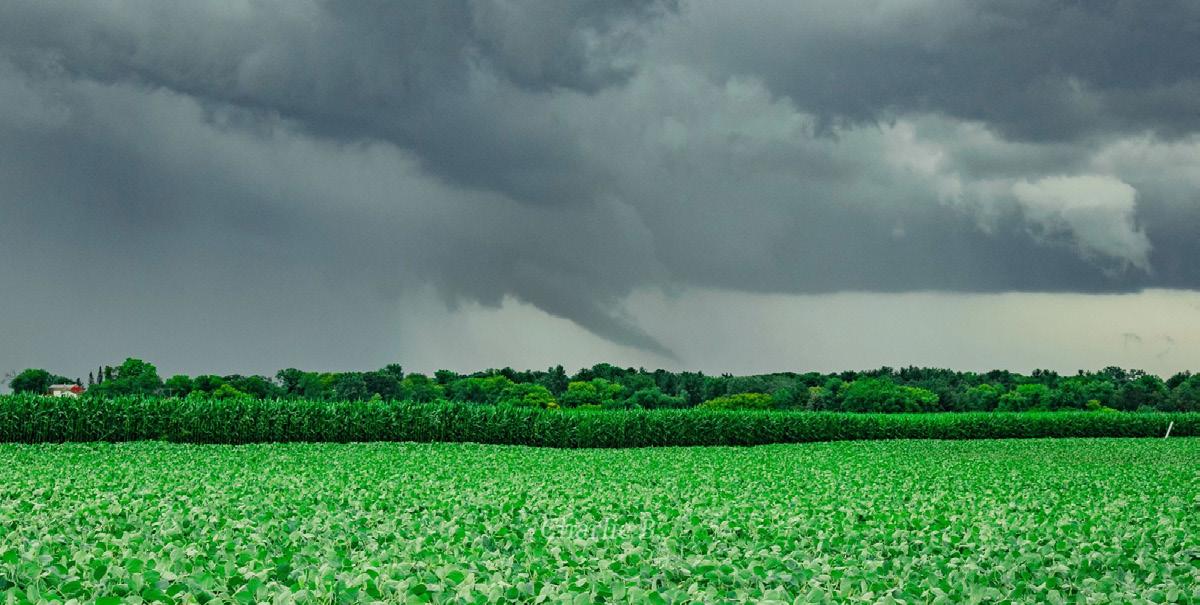
There are 141 outdoor warning sirens in Dane County, along with four sirens covering the entire UW-Madison campus.
Dane County Emergency Management emphasizes the importance of hypervigilance around severe weather threats on its website. While warning sirens quickly communicate impending danger, the department recommends residents use NOAA weather radios, smartphone apps and local media to stay up-to-date when
severe weather is near.
“We try to do as much as we can, but a lot of it is in people’s own hands,” Halbach said. “The success comes when the real days occur for severe weather and whether or not people are taking action at those points.”
Wisconsin has been the site of 1,537 documented tornadoes since 1844, according to the National Weather Service, with 511 fatalities attributed to these twisters.
President Joe Biden narrowly trails Republican former President Donald Trump in the race for the 2024 presidential election, according to a poll conducted April 3-10 from the Marquette Law School.
Among registered and likely voters, 51% indicated they support Trump and 49% indicated they support Biden. When including third-party candidates, 41% support Trump and 40% support Biden. Remaining voters support independent candidate Robert F. Kennedy Jr. at 13%, Green Party candidate Jill Stein at 3%, and independent candidate Cornel West at 2%.
Overall, voters surveyed said they are less enthusiastic to vote than before the 2020 election. In the current survey, 47% said they are “very enthusiastic” about voting in November, compared to 67% in March 2020.
Trump leads Biden in net favorability, enthusiasm
Despite the close presidential race, those more enthusiastic to vote considerably preferred Trump to Biden. Trump supporters made up 59% of the “very enthusiastic” voters.
Both Trump and Biden were viewed more unfavorably than favorably, with Biden’s net favorability at -19%, close to Trump’s -13% rating. Biden’s net favorability has been increasingly negative, while Trump’s has been less net negative since its -24% peak in November 2023.
When given seven issues — immigration and border security, the IsraelHamas war, the economy, foreign relations, Medicare and Social Security, abortion policy and health care — respondents felt the economy was the most important issue.
Respondents perceived Trump as more capable to handle immigration and border security, the Israel-Hamas war, the economy and foreign relations. Biden was perceived as more capable of handling Medicare and Social Security, abortion policy and health care.
Wisconsin Senate race close
Democratic U.S. Sen. Tammy Baldwin and Republican challenger Eric Hovde each held 50% of support among likely voters polled. When including undecided voters, 44% supported Baldwin, 37% supported Hovde and 18% remained undecided.
Baldwin’s net favorability improved from -3 to 5% since January, while Hovde’s
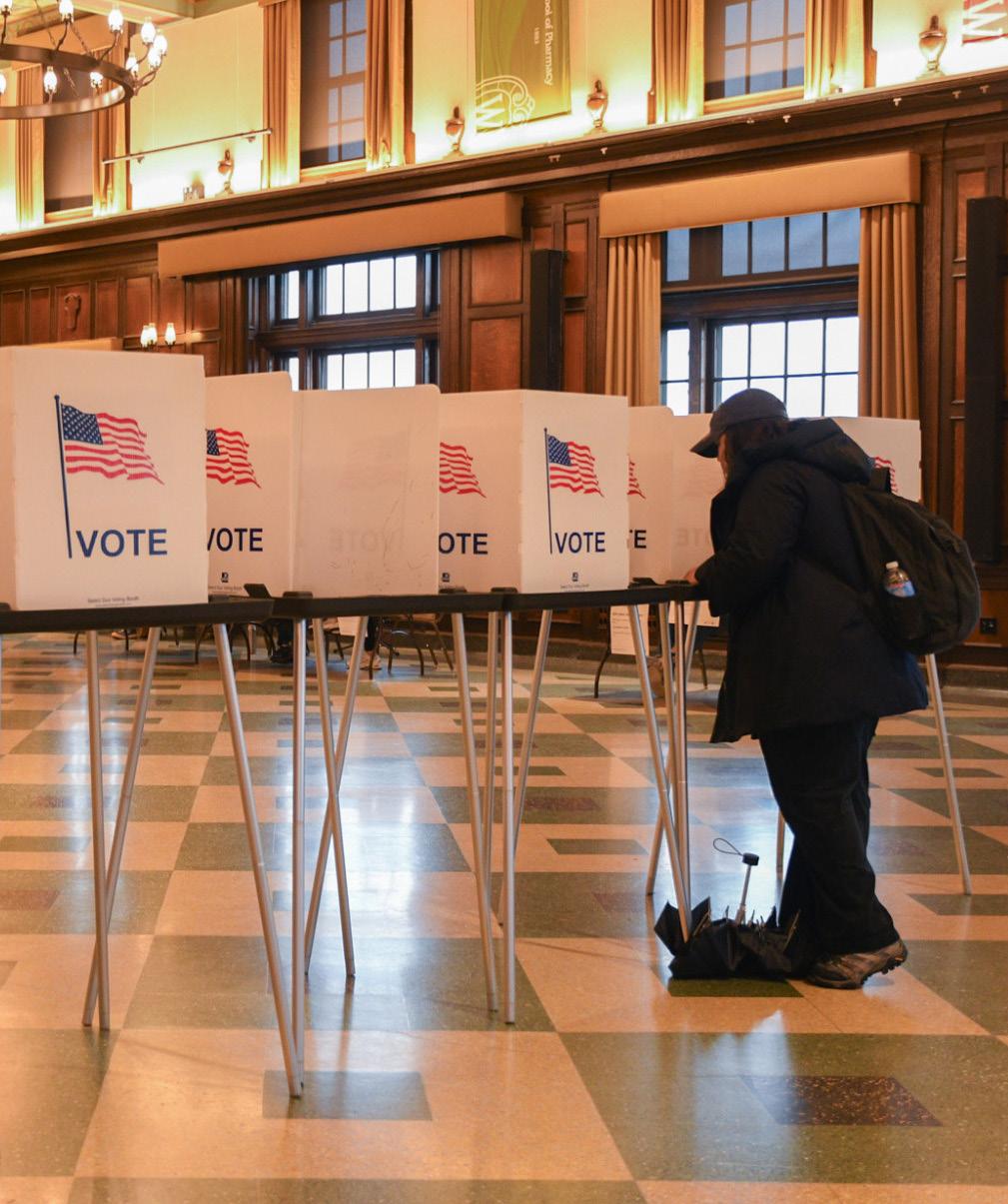
fell from -2 to -5%.
A majority of registered voters (59%) said the state of Wisconsin is on the wrong track, while 41% said it is headed in the right direction.
Supreme Court support low
Of those polled, 53% said they disapprove of the way the U.S. Supreme Court is handling its job. A sizable majority (70%) of respondents had “some to no confidence” in the Supreme Court as an institution and half of respondents said they think politics motivates Supreme Court justices’ decisions.
A majority of respondents guessed most of the current U.S. Supreme Court justices were “probably or definitely” appointed by Republican presidents. A quarter of respondents guessed most were appointed by Democratic presidents.
Three justices were appointed by Democrats and six were appointed by Republicans.
These responses come almost two years after the decision in Dobbs v. Jackson Women’s Health Organization, a 2022 ruling that overturned the right to abortion granted in Roe v. Wade. A majority of the public — 62% — said they disapproved of the court’s decision to overturn Roe.
The Supreme Court is currently reviewing a lower court decision that would significantly restrict access to mifepristone, a medication used in medical abortions. Of Wisconsin voters polled, 60% said the court should rule to keep current access to the medication, and 25% said the court should rule in favor of the lower court and restrict access to the medication.
The Chazen occupies a paradoxical space on the University of Wisconsin-Madison campus, wavering between its status as a hidden gem and a well-known tool used to rope prospective students into enrolling. On any given day, there might be a tour group huddled together in the lobby or a long line at the cafe.
Yet, these groups barely venture beyond the first floor to upstairs exhibit areas teeming with art.
Until the last few days of my freshman year, I was one of the people who’d never fully explored the Chazen. And even my discovery was made because I was showing it o to a family member in town.
For wandering eyes perusing the Chazen’s less than 1,500 items currently on view, it’s hard to imagine there are any unseen pieces left in the museum.
Spoiler alert: There are around 23,500 of them.
Those 23,500 pieces reside in the Chazen’s storage, a spot unknown even to most who browse the Chazen’s upper floors. The storage space consists of separate rooms where the art lays dormant and is cared for when not on view.
Last October, I took a tour around the storage area to highlight the people, processes and pieces that upkeep the Chazen’s prized possesions.
One of the first things that stood out when Exhibition and Collection Project Manager Kate Wanberg and I first entered the storage room were large, black sculptures that reside on the shelves facing the doors. Wanberg told me they are part of a larger piece, one with many moving parts that requires precise display.
The piece is called “Rhyme,” by Tenmyouya Hisashi, and it
came with two large illustrations: black boulders, and about two tons of red sand to be raked like a Japanese sand garden.
“This is one of those installation pieces where you never see the whole thing together until it’s actually in the gallery,” she said. “You don’t really get a full sense of the object just from storage.”
This is the position most stored art pieces find themselves in: condensed and disjointed.
Some of the larger paintings in the room are hung on large, rollout racks designed to maximize the amount of art kept in one room. One in particular stood out: a large, 60- by 84-inch painting that stands out against the gray walls of the room. The painting is dominated by a dark,empty museum room. However, in the next room over, there appears to be natural light which floods into the room. Like a black hole, it commands your attention.
There’s no title, but the piece is from 2002 by David Klamen, who had an exhibit in the Elvehjem dedicated to his works in 2004 and 2005.
Many of the larger paintings are stored on these rolling racks. But others, like sculptures, need to be stored based on their unique shape. As we walked around another storage room, Wanberg highlighted one sculpture as an example.
It’s a statue of a young girl with her hands braced on her knees. When fully assembled, the piece — “Flower Girl,” by Cynthia Consentino — portrays the girl vomiting up flowers. There are more than five parts to the piece, all of which are stored separately near the largest piece, the statue of the girl. She leans forward, braced to protect herself in storage, though there is a plastic piece in front of her to prevent the girl from falling if she were to tip forward.
Wanberg said many of the pieces in storage have their own protection systems designed to ward o signs of age and to
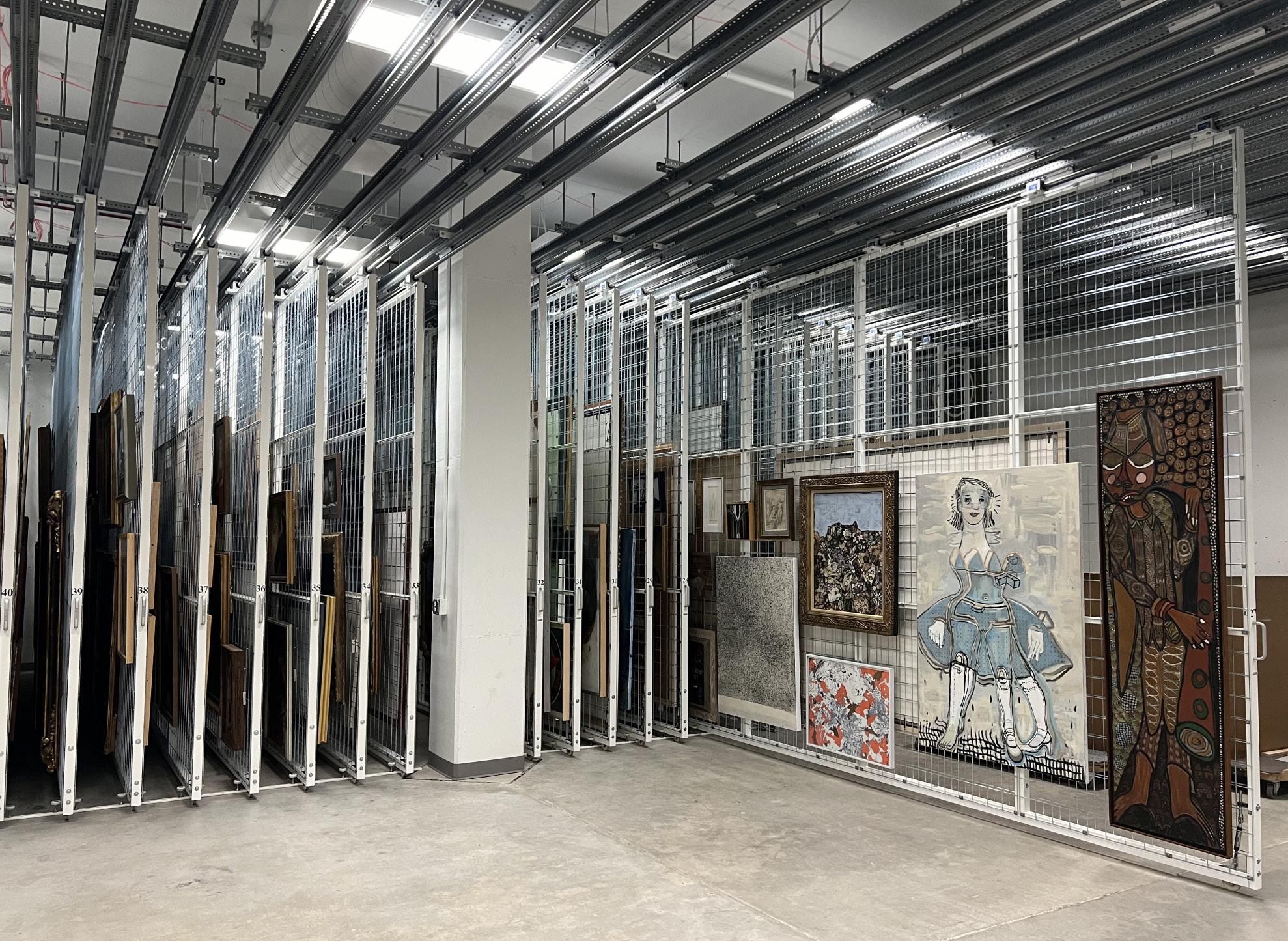
prevent damage.
“Some things will get really specific storage mounts to protect them,” Wanberg said. “We have to think about creating and fabricating things to keep them safe.”
As she opened one of the moving cabinets, she showed me a piece that is usually displayed standing up but was laid down for storage. Wanberg said museum sta built an elaborate, custom-fitting casing with acid-free materials to protect the paint and prevent cracks in the wood.
“Every time we put an object into storage, there’s the consideration of how would we display this versus how would we store it?” she said.
Over in the Works on Paper storage area, Chazen Academic Coordinator Mieke Miller had to peel a thin layer of wax paper o of every piece. The paper prevents

dust or any other unwanted particles from settling on the art and potentially harming it.
Like the Works on Paper room, each storage area has specific climate conditions meant to facilitate art preservation. Everything in the space is humidity- and temperature-controlled, and the lights are usually o to prevent pigment fading.
As we walked around the room, Wanberg and I stumbled onto a cart with brushes of all shapes and sizes, among other tools. In her job, alongside overseeing installations and preparing artwork for display, she also helps take care of items in storage. The items on the cart, she told me, are for preservation, often confused with conservation.
“Preservation methods are thinking about how we care for the object without really doing anything permanent,” she said. “It’s nonaggressive techniques that are just going to promote the well-being of the artwork.”
Conservation, on the other hand, utilizes chemical processes to restore art and is a more “drastic” method of preserving art.
“If you’ve ever seen the videos of conservationists removing varnish with q-tips and allowing the brightness of the painting to shine through once again, that’s conservation,” Wanberg said. “This process, however, is often performed externally to museums at labs that have the correct training, tools and chemicals to execute the process.”
These pieces can make their way out of storage, though briefly, for academic visits. Miller often coordinates with professors or teaching assistants to create short programs for students to come in and analyze relevant artwork. It’s an exercise in critical thinking but also a display of the depth of the Chazen’s collection.
During one of these visits, Miller brought out a print with bright colors and graphic outlines that deeply contrasted its subject matter. “American Guardian,”
by Roger Shimomura, depicts a sniper perched in a tree with his gun by his side and his binoculars focused on a small child riding a tricycle. The vivid colors and art style evoke pop art and graphic novel illustration styles of the 1950s.
In the background, however, lies a guard tower, and a barbedwire fence surrounds the neighborhood in which the boy plays. An educated guess and a Google search soon land you at the realization that Shimomura was drawing o of his own childhood in a Japanese internment camp during World War II.
The context of this piece brings a whole new meaning and another level of analysis, something Miller said she loves seeing students experience. She tries to pull diverse works for student viewing, opting away from all-white male European artists and instead toward showing works from all continents and walks of life.
“While [demographics] doesn’t always apply to the discussions the students choose to have, that’s something important to me,” Miller said. “It wouldn’t be an accurate reflection of the Chazen’s collection otherwise.”
Miller, who has a master’s degree in art history, recalled writing her master’s thesis on an engraving of the story of Adam and Eve by Albrecht Dürer and then later discovering a print of it was in the Drawing and Prints storage at the Chazen.
She said the Chazen’s sheer amount of art — and the fact that students are able to see the pieces through class meetings in the study room —- is a monument to academic curiosity and the desire to learn.
“As an academic teaching museum, we need to preserve things for the future, but we also want to make everything as accessible to our audience as possible,” Miller said. “Which is why having [the study room] is great.”
These pieces, despite being in storage, exist for those who ask.
As the year comes to an end, so too do the terms of 15 of The Daily Cardinal’s dearest editors. This year, they have spent hours toiling away in the windowless basement of Vilas Hall that we have the nerve to call an o ce. As the Cardinal prepares to turn over the reins to the next management team and crew of editors, here is what they will miss most from their days on the Cardinal. As these Cardinalistas depart the nest and spread their wings, we wish them all the best.

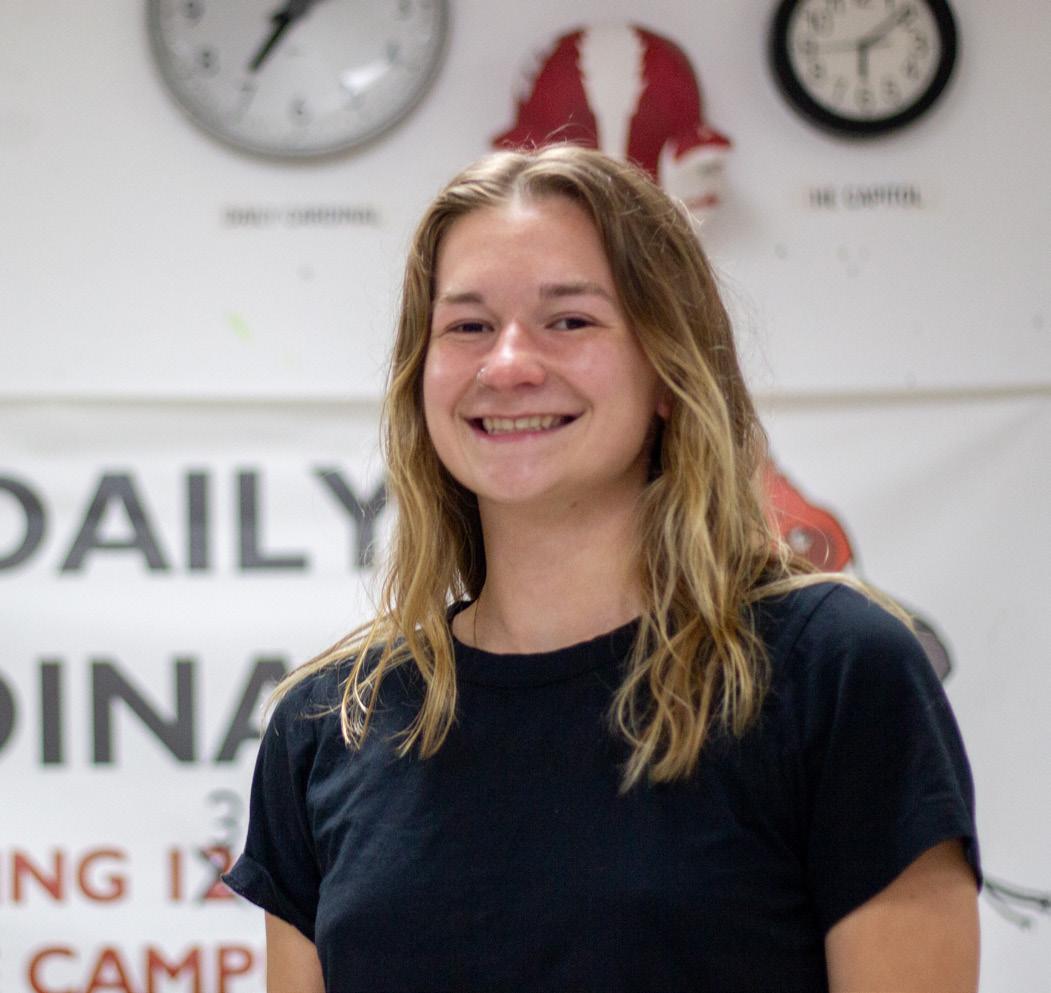
“I’ve enjoyed spending my days in the o ce. Before walking into 2142 Vilas Hall, I didn’t know I was going to be making almost all of my closest friends in that o ce. I can’t name one single favorite memory (there’s too many!). But I will never forget the wine nights, late night prints, rivalry sports games, Gameday handouts, power hours, and otherwise general tomfoolery I partook in with all of my Cardinal friends.”
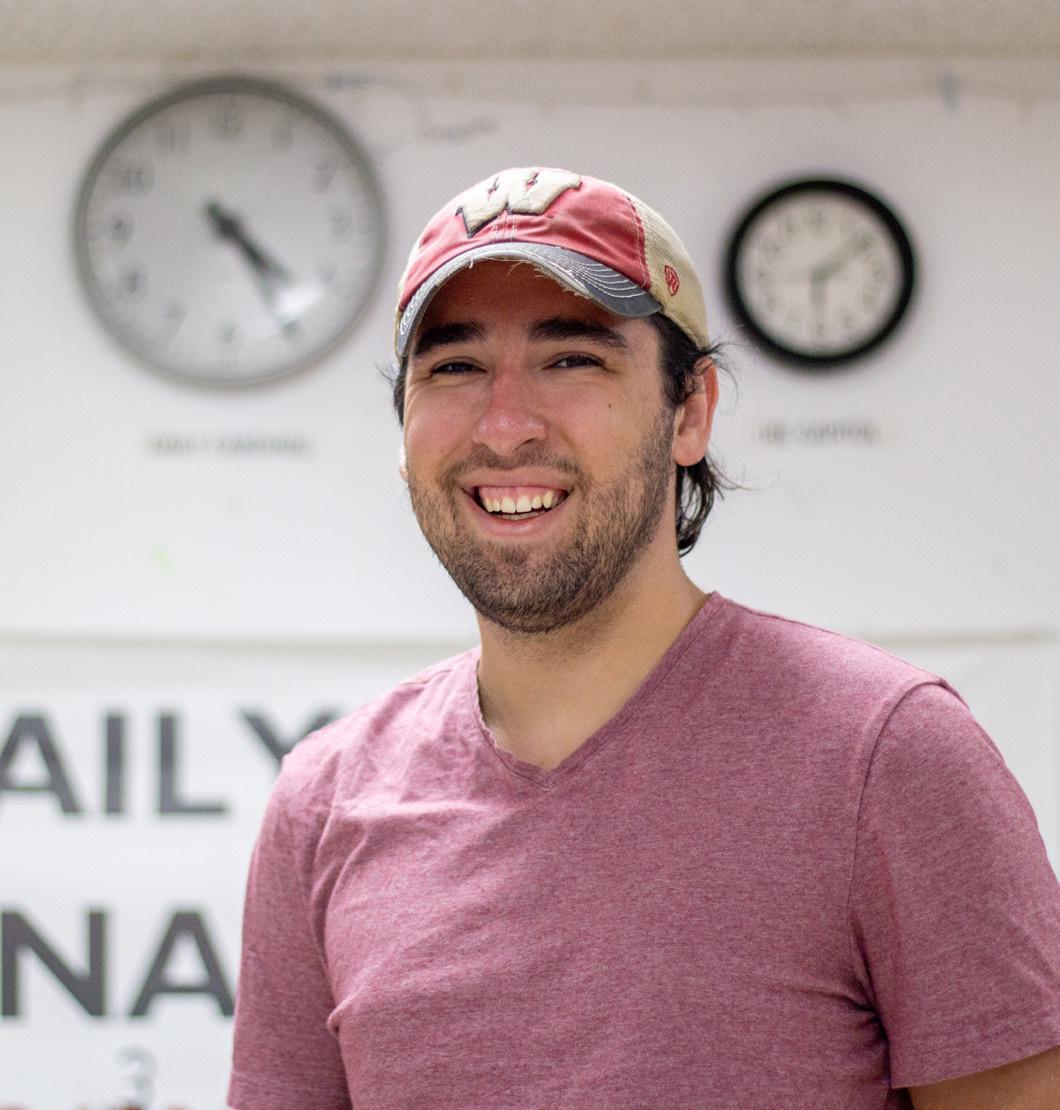
“My favorite memory I have from the Cardinal is playing in the annual softball game, it’s always so fun!”
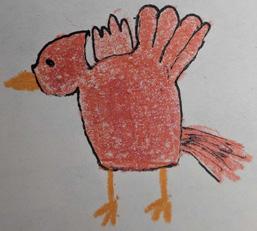
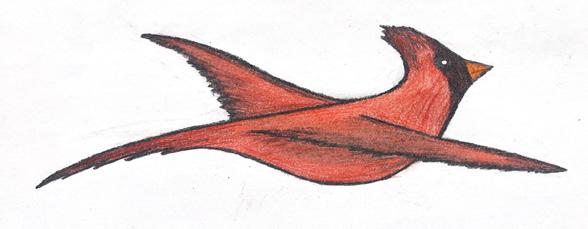
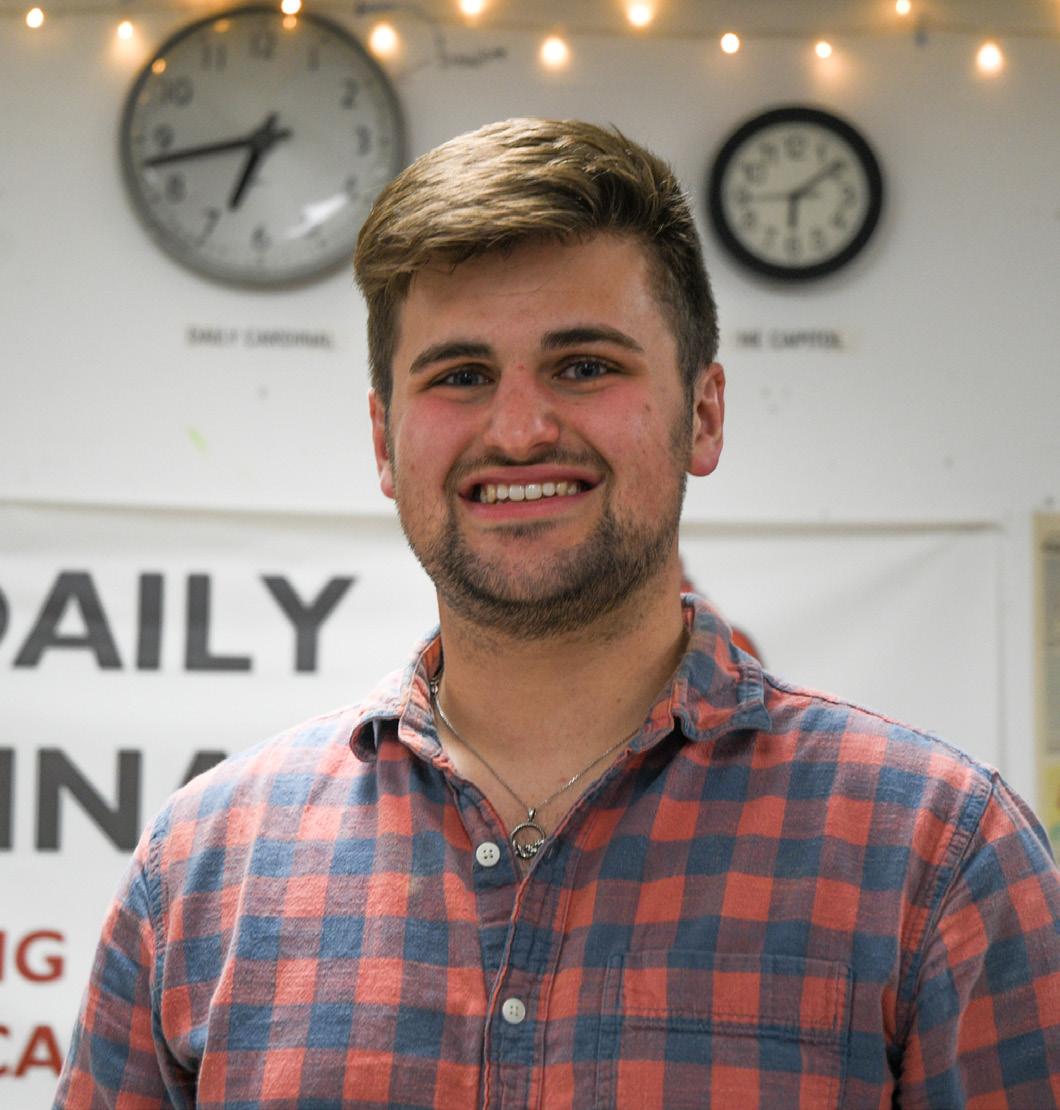
“Even when student journalism gets stressful or lowkey insane, I take comfort knowing I’m surrounded by kind, dedicated people who report because tbey care deeply about campus and their community. The Cardinal is where I found myself, and I’ve tried really hard to replicate that experience with other people. Watching my former state news dream team take over the Cardinal and become great friends with each other along the way is the culmination of that. It’s a proud dad moment, and I know I say that a lot, but it really means the world to me to see them succeed.”
“I got to know so many people and learn about so much. Making some of my best friends in college, teaming up for news stories and feeling myself grow more confident as a person has been the time of my life.”
“I think the Cardinal o ce is an incredibly special place to me, both because it holds an insane amount of history, but also because when you go there, you don’t go to work, you go to be around people. Great journalism is a given with the Card, but wonderful people is perhaps its best quality.”
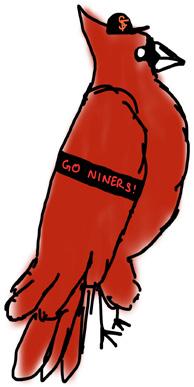
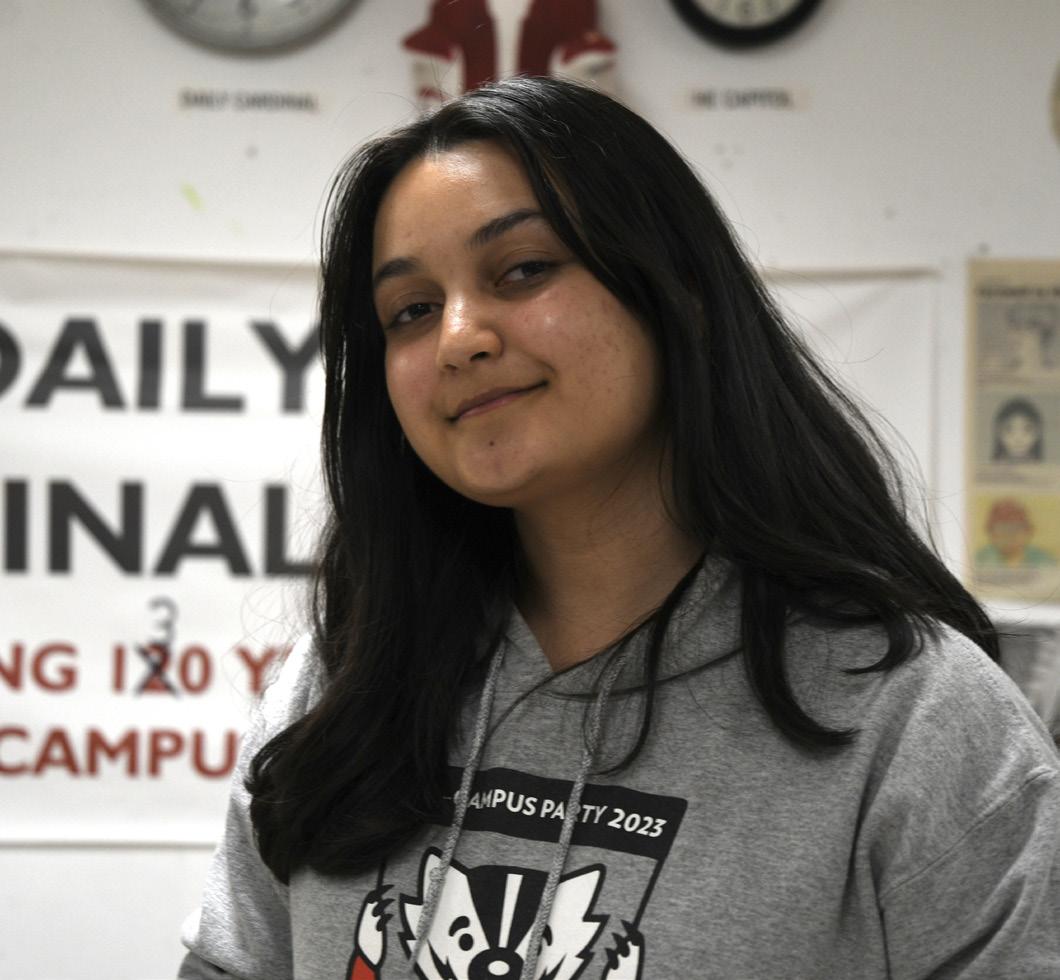
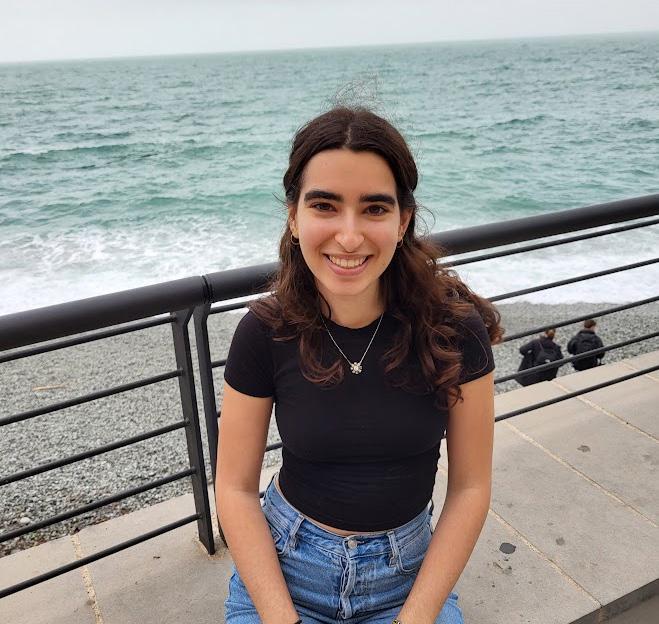
“I’ve most enjoyed getting to read everyone’s stories and be a part of an amazing paper! My favorite memories from the cardinal are late night print nights at the copy desk.”
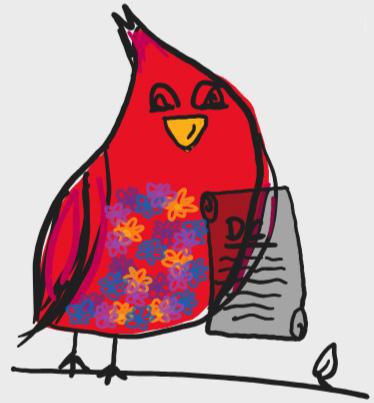
“Being supported and encouraged by the sta around me to continue growing my editing, writing and InDesign skills has been so special. My favorite memory is any print night that runs late. The more exhausted and loopy we get, the more wild our conversations and o ce antics become.”
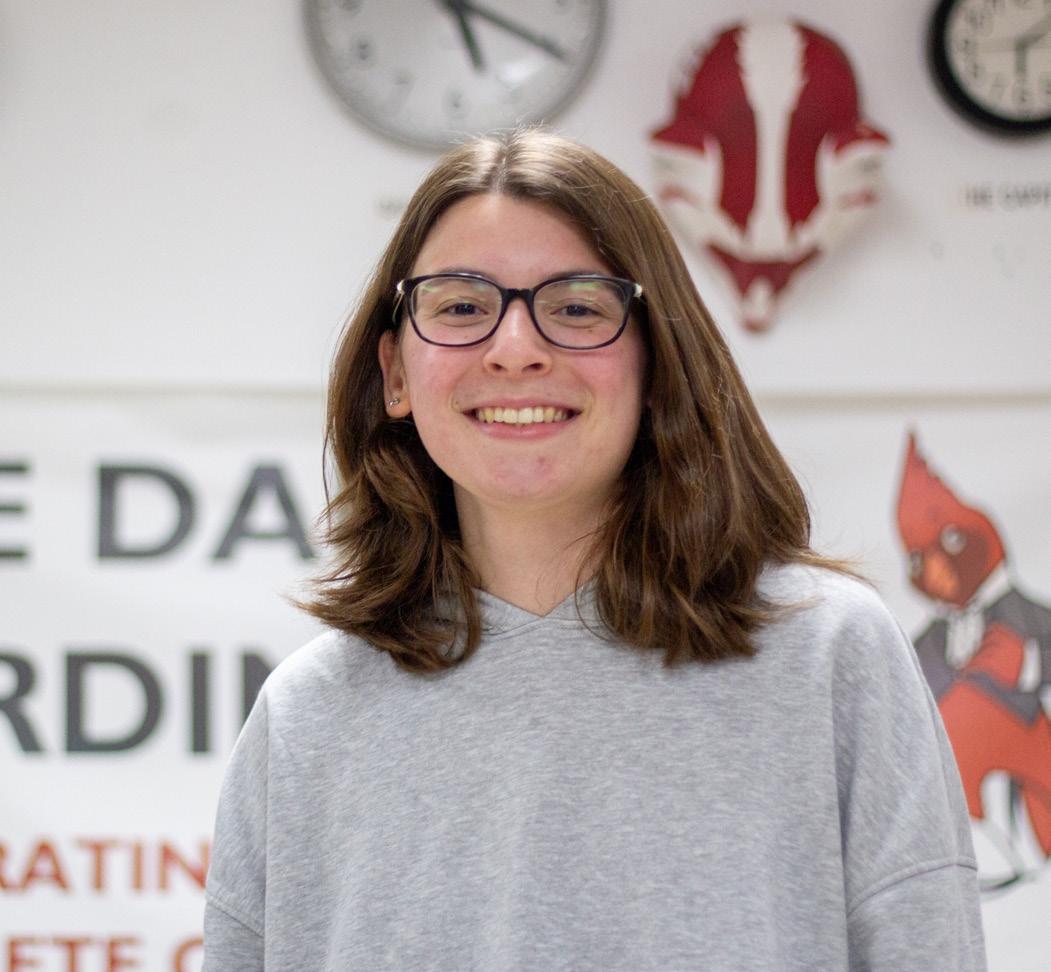
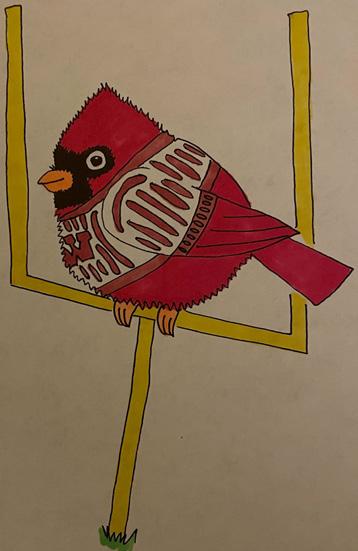
“I’ve definitely enjoyed being able to see writers grow at the Sports Desk and meet new people with a bunch of di erent viewpoints. It’s been really neat to see writers in the same position that I was at freshman year, having never written for a paper before, and be able to guide them through that process as an editor now.”
“I never thought I would enjoy hanging out in a dingy o ce as much as I do and it’s because of the amazing people I’ve met.”
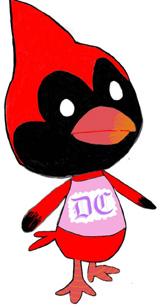
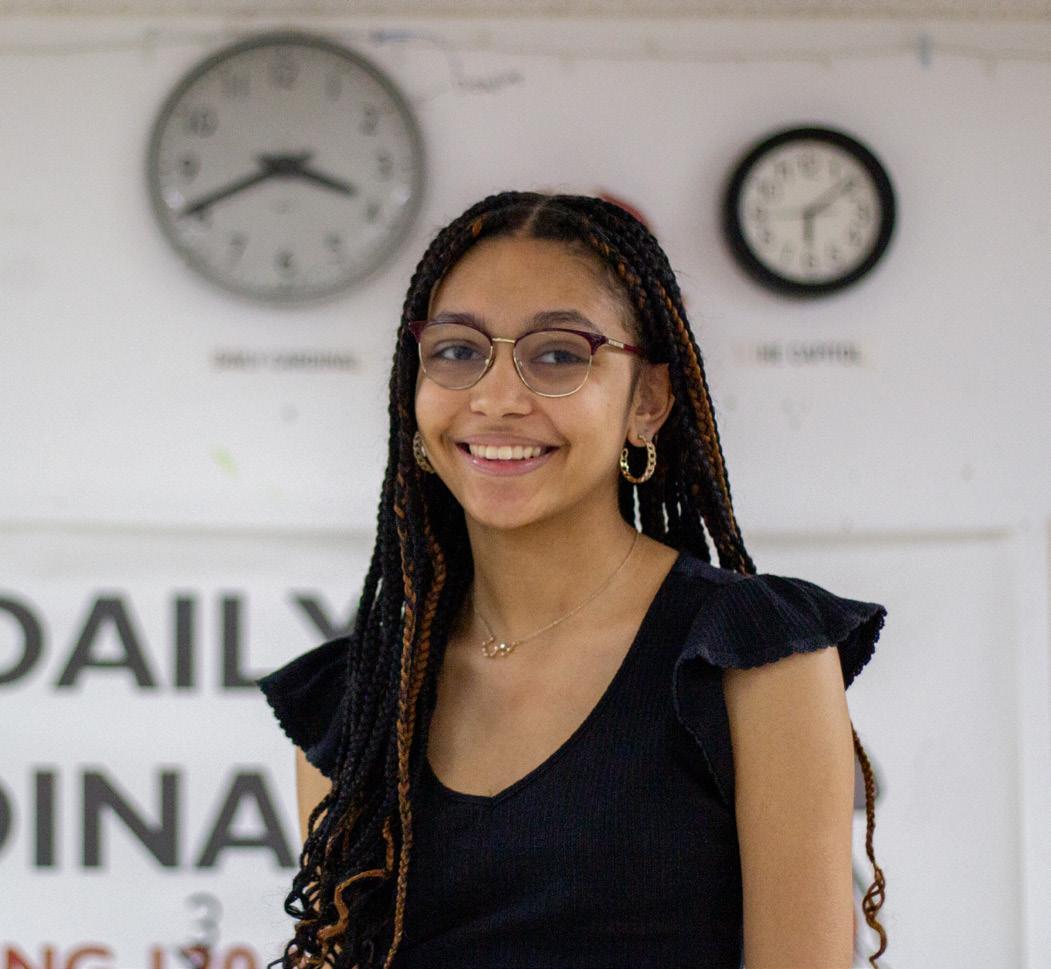


“The community and passion of the people who make up the Daily Cardinal, from the writers to editors and everyone in between. It’s obvious from the get-go that everyone cares so deeply about the Cardinal and the work we do, it was impossible for me not to adopt that sentiment.”
“I’ve appreciated the chance to share the wonderful world of science with a sta who supports my curiosity - I love seeing everyone’s eyes light up when I tell them about new research we’re covering or request a silly bug drawing in the graphics channel.”
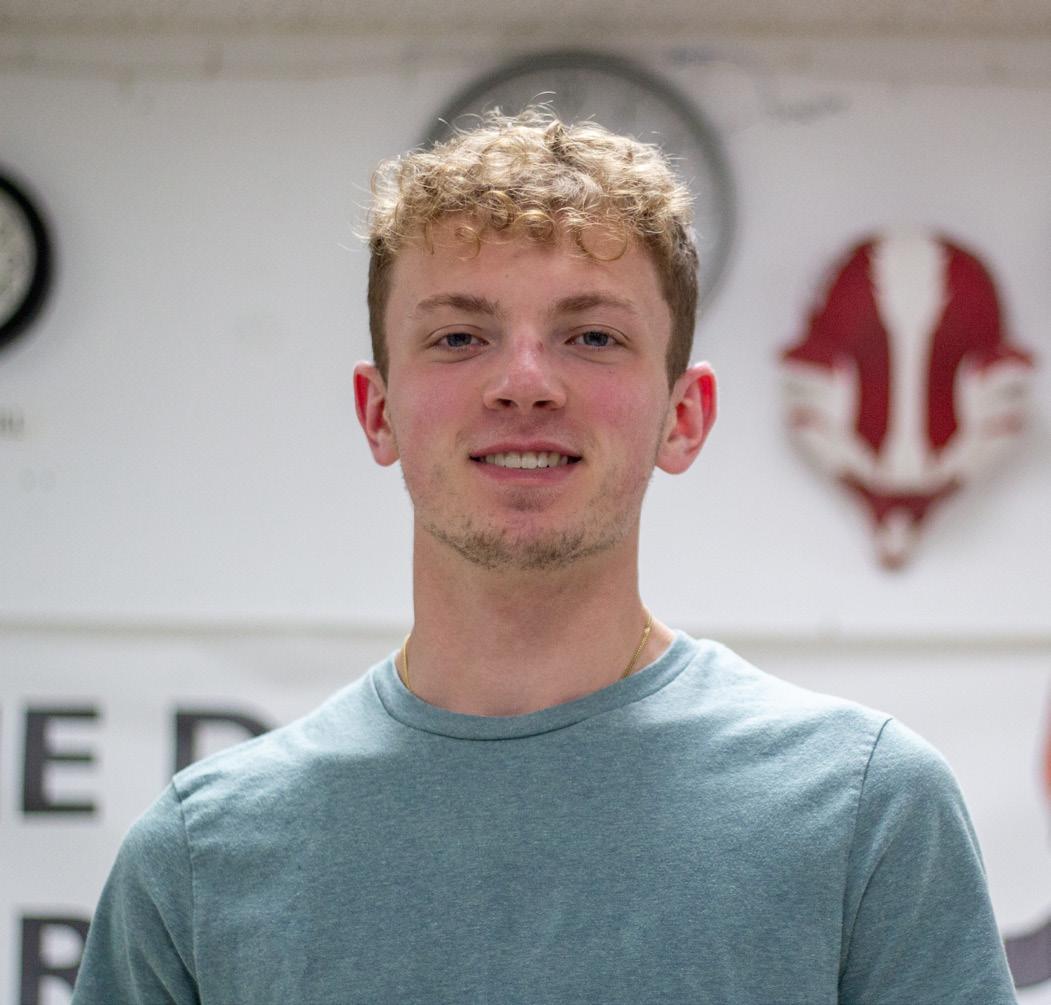

“I’ve enjoyed the opportunity to help our sta expand their boundaries and allow them to gain new and valuable experiences in the sports journalism realm. My favorite memory with the Cardinal was my first press conference at the Kohl Center, I’ll never forget how massive all the players were in person. “
“A favorite memory I have from the Cardinal is my Podcast Director election. I remember being really nervous but it was an incredible feeling when I o cially got the role. I felt like my two years of hard work at the Podcast desk had really paid o and prepared me well, and it was very rewarding.”
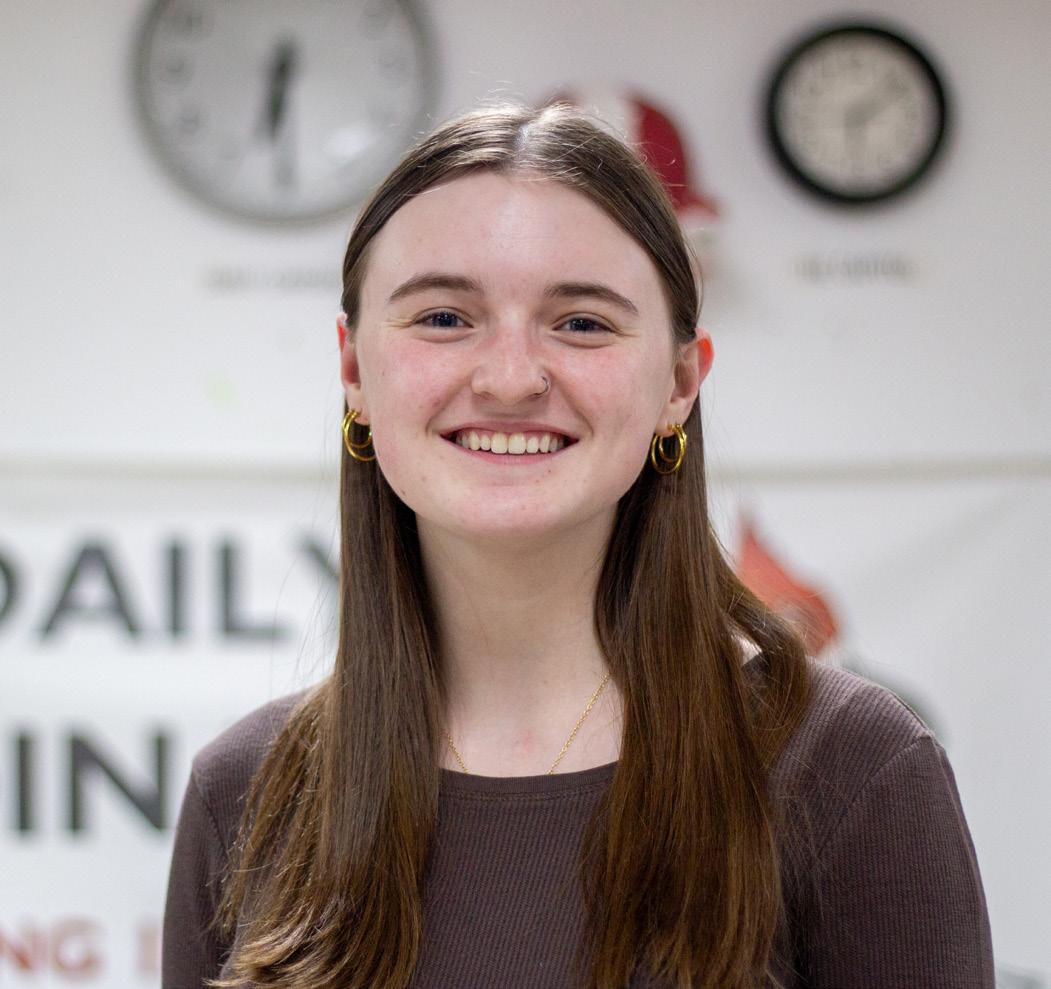
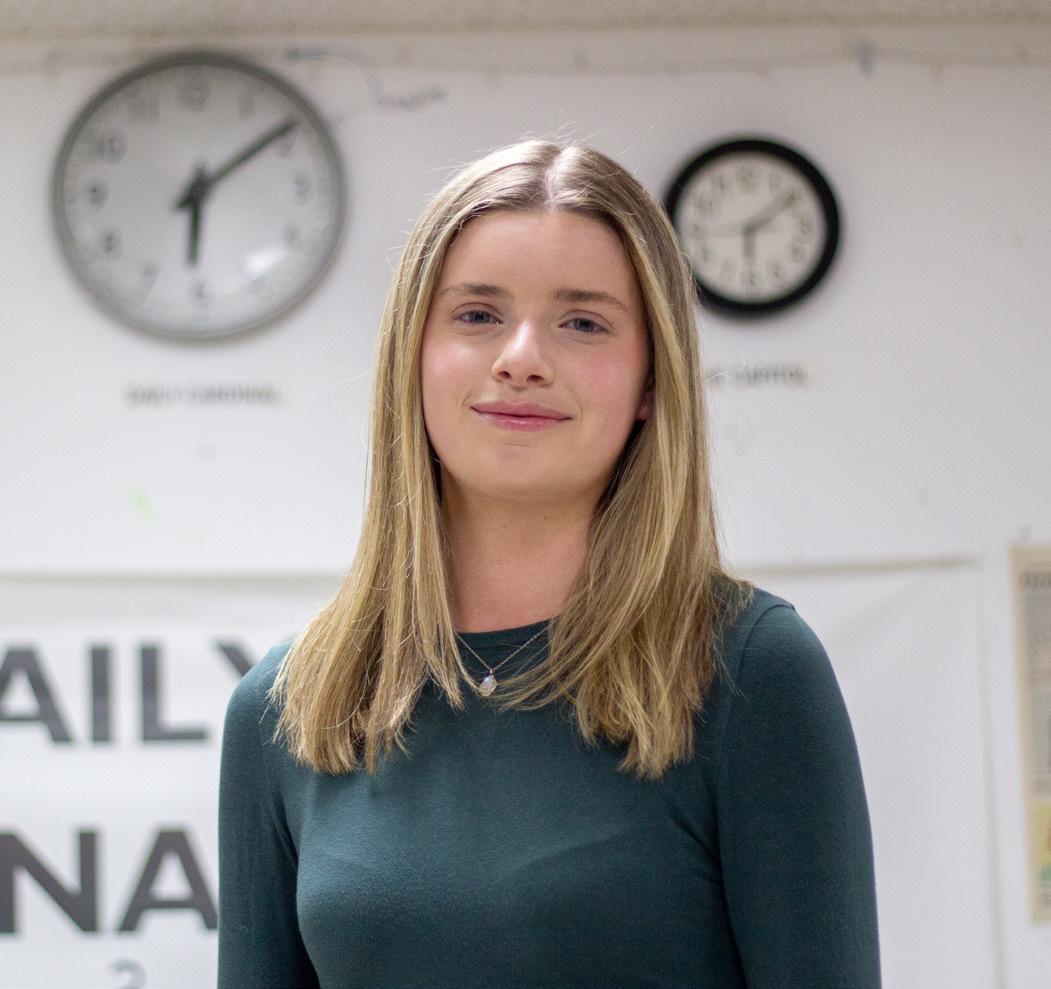

“I’ve loved getting to chance to welcome other writers into the Cardinal and help them learn and grow their skillset, just like previous editors did for me! Working on the fall 2023 Action Project, I had such a great time writing about Slow Food UW, and learned a lot while doing it!”
“The thing I have enjoyed the most is getting to run a team of passionate individuals who are helping to make our online presence grow! My favorite memories come from hanging out in the o ce and talking to everyone that passes through. I love the people in this newspaper so much!”



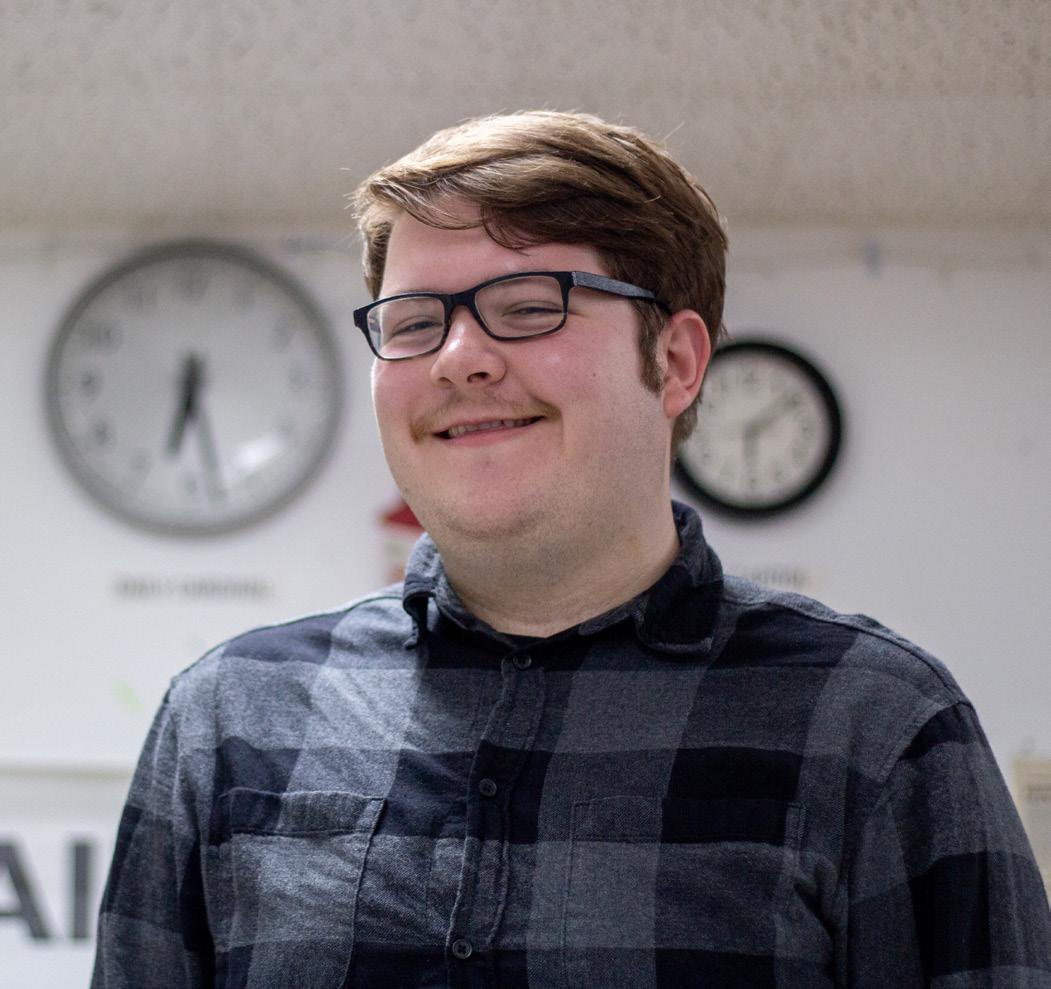
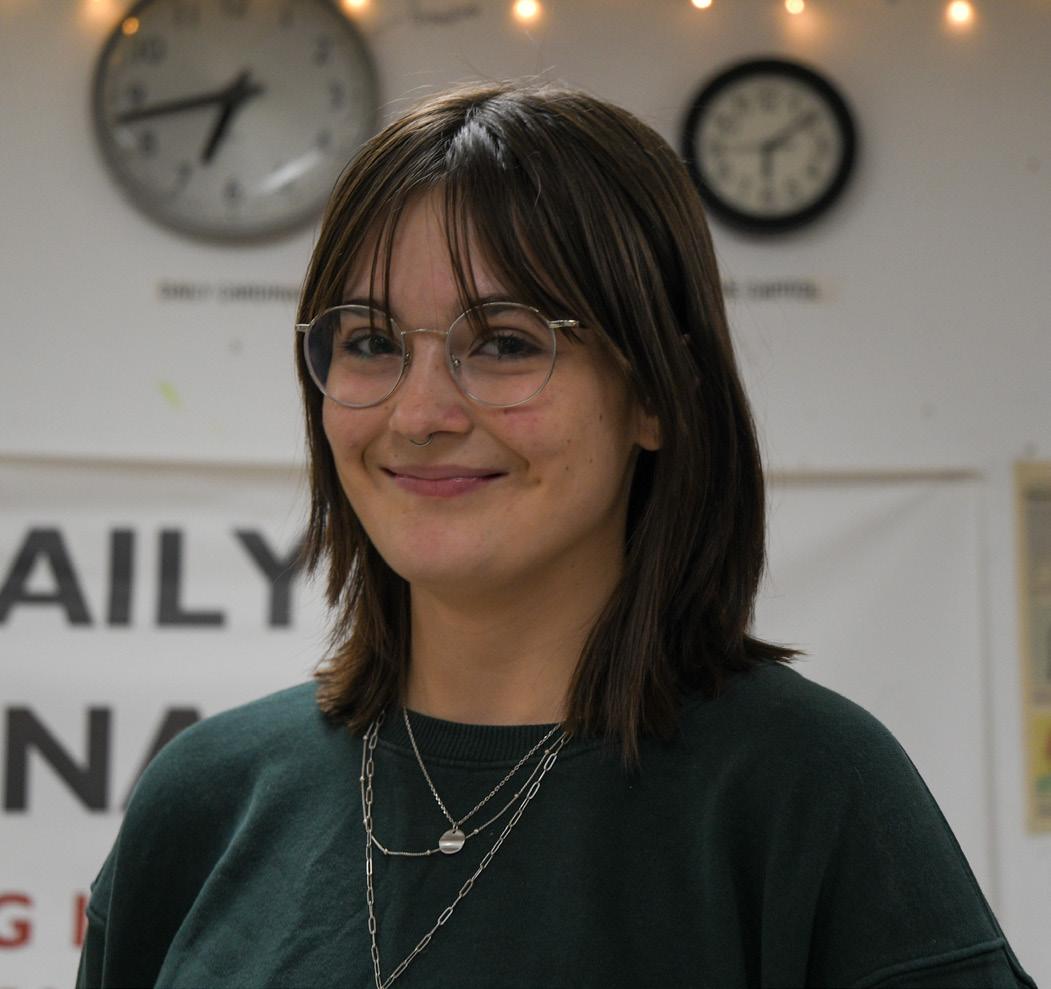
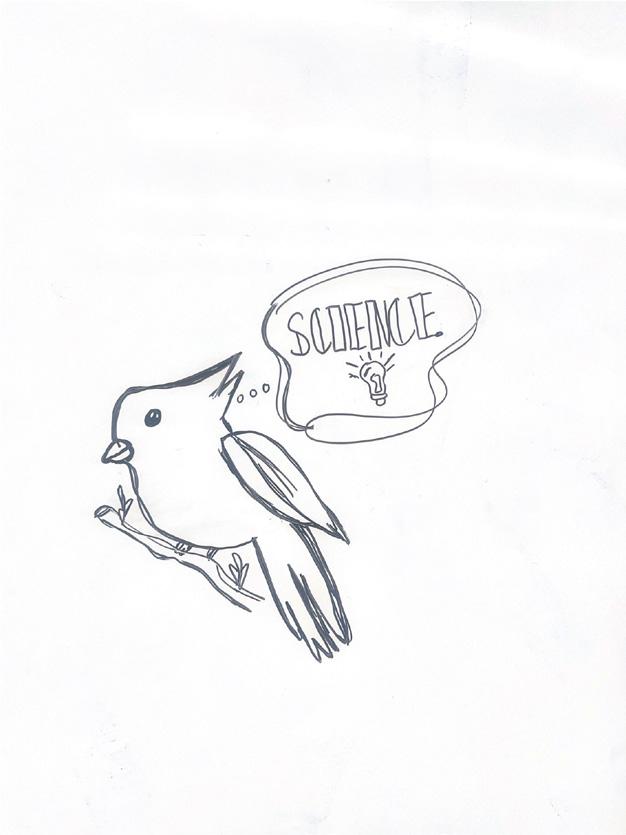

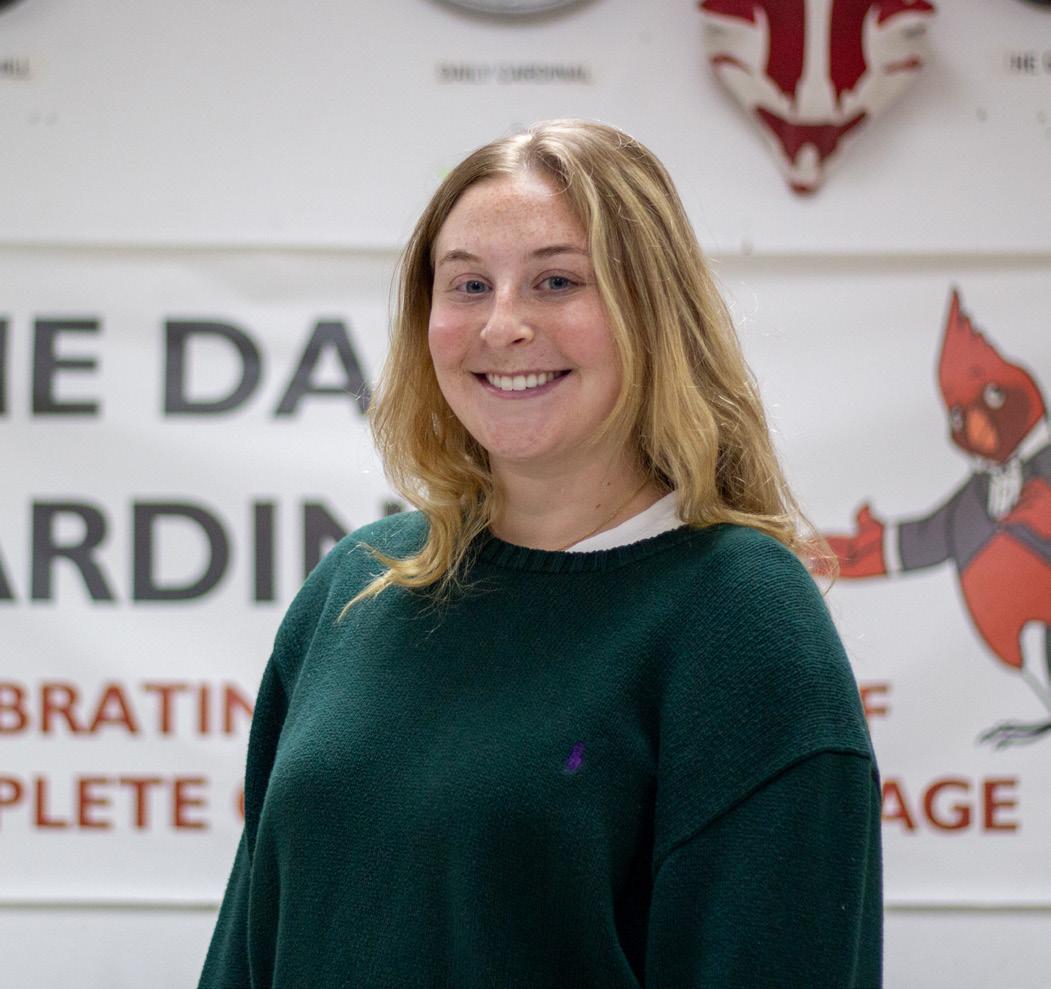
In my final weeks at the University of Wisconsin-Madison, I was utterly betrayed by Transportation Services when it impounded my car for multiple unpaid parking tickets. Now, after paying o all the tickets and getting my car out of impound, I’m taking swift revenge.
I’m going to cause at least $270 worth of property damage to UW-Madison on May 3 between 5-10 p.m. Possibly $271 so I’m up.
On Tuesday, April 23, I was the victim of a horrible injustice at the hands of UW-Madison’s fascist, possibly racist, Transportation Services, deciding to impound my 2018 BMW X1 for $270 worth of unpaid parking tickets. After another riveting Tuesday morning half-asleep in my James Joyce course, which happened to meet at 7191 Hellen C. White for a screening of the movie version of “Ulysses” instead of in the depressing Humanities building as usual, I was shocked to find my 1-ton pedestrian mower gone.
My mind raced thinking about the possibilities. Surely no one stole it — I hoped — since there was no more glass on the ground than normal in this filthy city. My heart dropped as I spotted a blue envelope in the grass in front of where I parked. It was the decoy ticket I never paid to avoid more tickets. I instantly knew what happened: Transportation Services took away my transportation.
I sat in front of Lake Mendota not overcome by overwhelming motion sickness from bodies of water for the first time. It was a
miracle. The cure for motion sickness is getting your car towed. After a few minutes scrolling through Transportation Services’ page, I found where they send all the naughty cars: Schmidt Auto.
I hastily called the tow yard to figure out what it was going to cost me. Apparently, it just arrived there. I missed avoiding paying the exuberant, balderdash fines by mere minutes. The lady was nice and told me that there would be no charge from them since it just got there. Still, my car was being held for ransom contingent on me finally paying o all the tickets.
It was a 50-minute walk, so I called an Uber because I refuse to ride the bus with the poors. The driver’s name was Tasir.
Tasir was literally right next to me when I ordered the Uber but pulled past me a whole block away. He realized and just sat there in the street. I wasn’t going to run. My car got towed. I was already sad. I entered his Black Toyota with the standard Arabic greeting of “Assalamualaikum.” He ignored me. I knew that I was going to get there in record time. We got there in five minutes. Tasir can push a whip. I stepped out into Schmidt Auto on Beld Road and instantly looked for my missing boy. I saw the gate open and contemplated just hopping in there to take back my property, but another gate would have stopped me. BMW parts cost a lot. I couldn’t a ord it on a measly reporter’s salary.
I stepped into the shop where the lady instantly knew who I was (I called five minutes before) and asked me how I was doing today. What a condescending question. I was forced to pay an unjust levy for the privilege

of parking where I shouldn’t have.
I handed her my ID and showed her the proof that I paid the tickets. Then, she handed me a safety vest to go walk into the impound yard to get the car myself. Not even full service. What the hell am I paying for? I pulled around back to the entrance because she needed my insurance. Not sure why, but I hope this won’t a ect my rates on my expired insurance from Iowa that she didn’t check the date on.
I asked if I could keep the vest, and she responded with a stern “no.” This was the second most devastated I’ve been that day.
You may be thinking this is all my fault, but I don’t believe in paying for parking at a place that does land acknowledgments. This is stolen land after all. I shouldn’t have to pay for parking on stolen land. Now, the colonizers have once again stolen from brown folk in pursuit of their endless siege against the nonwhite, non-Christians in the name of their “claim” to the land.
I think it’s only fair that now I, Omar Taimoore Waheed — grad student typically found in Vilas between 3:30-6 p.m. on the fifth floor — gets to destroy at least $270 worth of property at UW-Madison as reparations.

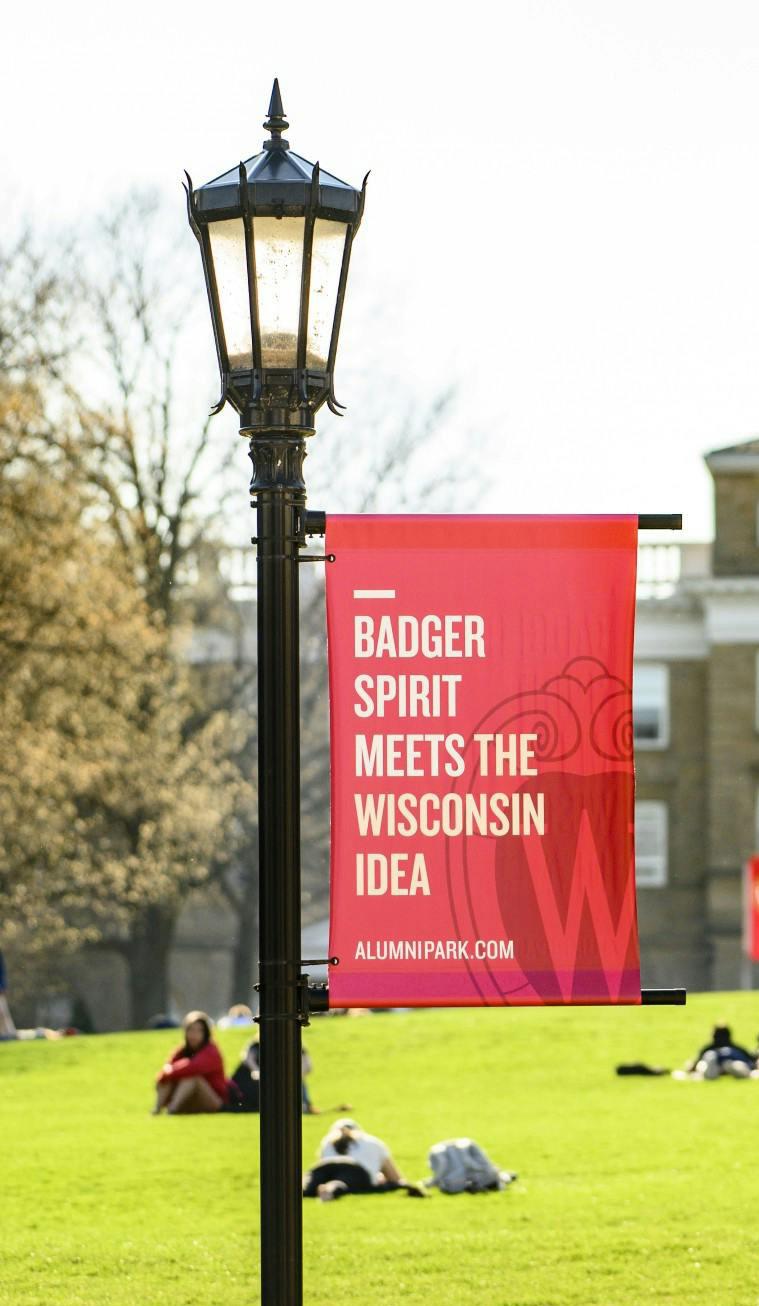
The student-run publication Moda Magazine hosted a fashion week on the University of Wisconsin-Madison campus from April 15-19, featuring inclusive, creative and exciting events that culminated in a fashion show.
Moda kicked off fashion week with a headshot booth for students who needed pictures or those who were interested to come and get their headshots taken.
Students were also able to donate clothes to Luke’s Closet, a Dane County clothing bank for children in foster and adoptive families.
“All of the clothes that are donated today, we’re going to give to Luke’s Closet,” said Adina Kurzaban, Moda events planner. “[Luke’s Closet] is a local nonprofit that gives donated clothes to Hong Kong children in the foster care system who aren’t able to purchase clothes for themselves.”
Moda is focused on bringing the creativity out of students and giving all students the platform to get themselves out there, event organizers said.
“I like bridging creative communities in Madison, and I think that there’s something really powerful in student organizations working together to build a stronger community and Madison for Fashion
In anticipation for their spring edition, Moda Magazine hosted their 2024 UW Fashion Week (UWFW) last week, complete with five distinct events in collaboration with University of Wisconsin-Madison student organizations, local artists, small businesses and community partners.
The magazine’s weeklong event, titled “FUSE: Igniting Innovations,” was a celebration of Madison and the artistry the city inspires.
“FUSE isn’t a set of stagnant events, nor does it conclude with the final event of UWFW. FUSE is a creative ignition, sparking innovation and stoking the flames of creativity in Madison,” Moda said in a press release.
On the second day of UWFW, Moda hosted a Careers in Creative Panel featuring the wisdom and experience of three creatives in the realms of fashion, art and literature.
needed a change of pace, a decision that led to create of Happy Hours.
“I was living the Carrie Bradshaw dream, and I thought I had everything, but I wasn’t happy,” Gilbertson said. “It was really hard and scary for a couple of years. I didn’t know what I was going to do, but I never regretted it.”
Kellesvig cited a psychedelic experience as her reason for going back to graduate school at UW-Madison.
“I went to a Radiohead show in Chicago, did a bunch of mushrooms and realized I had to go get my MFA in painting,” Kellesvig said.
She attributed her three years in the program as some of the most transformative of her career.
“It helped me learn that I should make the work I want to make, not the work I feel like I should be making,” she said. “When we can start to di erentiate that feeling, we make big changes in our lives and big changes in the world.”
ent backgrounds, all three guest speakers agreed on one thing that was most pivotal to their creative careers: community.
“We often take for granted friends in the path of creativity,” Kellesvig said. “There’s this stereotype of artists sitting in a dark co ee shop with a beret and a cigarette, but we need community to help each other rise.”
Kellesvig and Gilbertson both shared their experiences leaning on friends during the creative process, whether that be celebrating successes, critiquing work or even commiserating together.
“Being around goofballs you are close enough with and can be honest enough with that they’ll challenge you while still knowing how to hold up your ego in the right way is crucial,” Kellesvig said.
Even from a corporate perspective, Perry credits much of his success to those around him.
Week,” said Emily Han, Moda coordinator of events. “We wanted this to be like an opportunity for a bunch of di erent student organizations to work together and put on events and showcase their many, many talents.”
Through the week’s events, Moda worked towards its goal of creating an inclusive environment where students can thrive.
To end fashion week, Moda hosted a fashion show at The Orpheum Theater titled “Fuse” where students could watch a production with 11 di erent designers, complete with live music by local artist Mars.
“My favorite part was seeing the joy and awe of the audience witnessing such unique forms of art,” said Chloe Joykelm, Moda coordinator of events.
As much as the week was meant to be a fashion experience, event organizers said the greatest underlying intention was bringing people together.
With the name “Fuse,” members of Moda hoped to use the fashion show to showcase talent in Madison and inspire student fashion designers.
“Moda is a welcoming and inclusive UW student environment in which shared interests of all aspects of life, culture, lifestyle, art and fashion can be expressed and shared through visual and written works,” Joykelm said.
Guest speakers Ali Gilbertson, owner of secondhand store Happy Hours, Claire Kellesvig, artist and lecturer at UW-Madison, and Chris Perry, author of the recently released AI and automation guidebook “Perspective Agents,” all o ered insights from their distinct corners of the creative world. Discussion spanned the topics of career risks, maintaining passion and finding value in your work.
For Gilbertson, the biggest career risk she took was moving out of New York City and back to her home state of Wisconsin. Gilbertson had spent nearly a decade working at an upscale thrift store in the city before feeling she
Prior to becoming an author and expert on artificial intelligence and automation, Chris Perry was a self-proclaimed “brickbreaker” on some of the largest accounts at communications consultancy Weber Shandwick. In his work with General Motors, Perry said he led his team through the social media revolution.
“As you get into the working world, you’re going to see things other people won’t, but it won’t matter unless you do something with it,” Perry said. “It’s one thing to see trends emerge. It’s a whole di erent deal to have the guts to go against the grain and realize the potential in certain things.”
Despite their wildly di er-
“Execution is 95% relationships,” Perry said. “It doesn’t matter if you’re creating artwork, a store, a plan or a business, real relationships and friendships are everything.”
Through risks, passion and community, Gilbertson, Kellesvig and Perry all distinguished unique careers for themselves and are now able to help foster the next creative generation. Even in an extremely STEM-based world, these three have never been more confident in the future of the creative landscape.
“The future is in the hands of the artists,” Perry said. “The artists are the people that are going to make sense of phenomenons that we’ve never experienced before. They’re going to create new ways of seeing the world.”
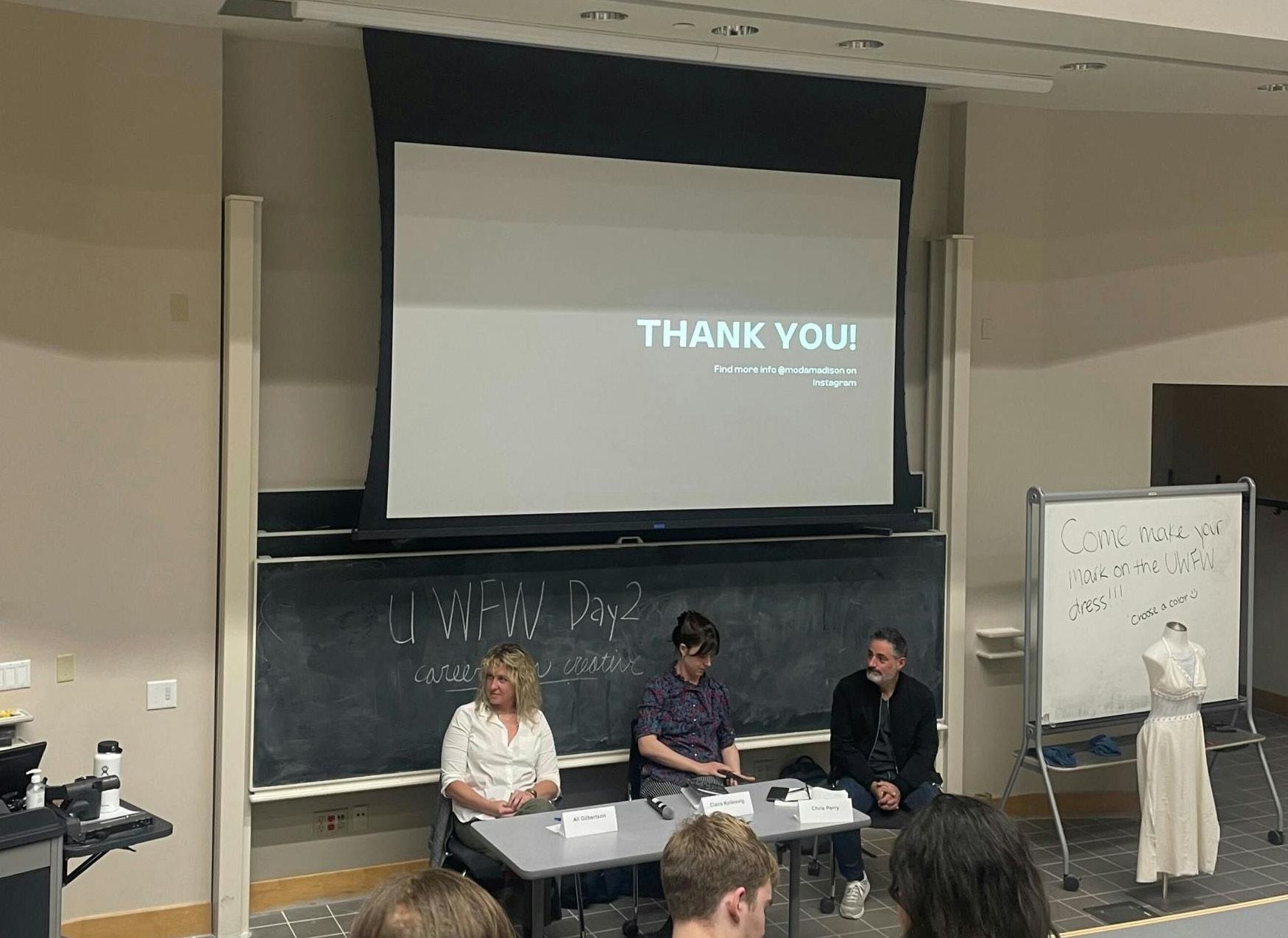
Police have been attempting to put an end to Mi in for years, but at what cost?
By Ava Middleton STAFF WRITERAs the end of April approaches, campus is bustling with excitement for this year’s Mifflin Street Block Party. “What are your plans for next weekend?” seems to permeate every conversation I’ve had this week.
For years, the Madison Police Department and UW-Madison Police Department have been trying to shut down the event while ignoring its roots in tradition and history.
The event initially began as a protest against the Vietnam War led by the Mifflin Street Community Co-op in 1969. The mayor at the time was viewed as the embodiment of the political culture that the co-op stood against in the face of the war. The protest caused Madison to make history as the site of the first lifestyle riot in the United States, according to author Stu Levitan.
The first Mifflin sparked a change in how police approach protests, and it sparked efforts to build a better relationship between police and students so that nothing like the initial riot would happen today. The block party reminds the university each year of a well-loved tradition and the importance of standing up for one’s beliefs.
So why are Madison police trying to shut down an event so deeply intertwined with the history of the city?
Last year’s block party ended in more than 44 arrests along with property dam-
age, injuries and overcrowding of porches. With these ever-rising numbers, Madison Police Chief Michael Hanson said last year he was committed to ending Mifflin.
Hanson has since softened his stance, a smart move given his initial comments were a far too unrealistic view of the situation. Many Mifflin residents believe that it is up to their discretion what they do in their own homes. Additionally, many students did not feel threatened by partygoers, nor did they have any problems trying to lock down their homes from unwanted people. These statements are a clear demonstration of the event as a celebration of camaraderie among the entire student body.
What’s more, Mifflin is a time for students to come together before finals week and revel in the rare warm weather. Shutting down the event would be stripping students of the opportunity to celebrate the end of the semester.
As for the state of this year’s Mifflin, it is still on. As opposed to attempting to end the event completely, police and District 4 Ald. Mike Verveer has been taking measures to promote safety instead. Police are offering themselves as a resource if needed and suggesting limiting the amount of people on one property. The block party should be secure with the 100 police officers they plan to have present.
Make no mistake, besides the push toward securing the event this year instead of shutting it down, the police will
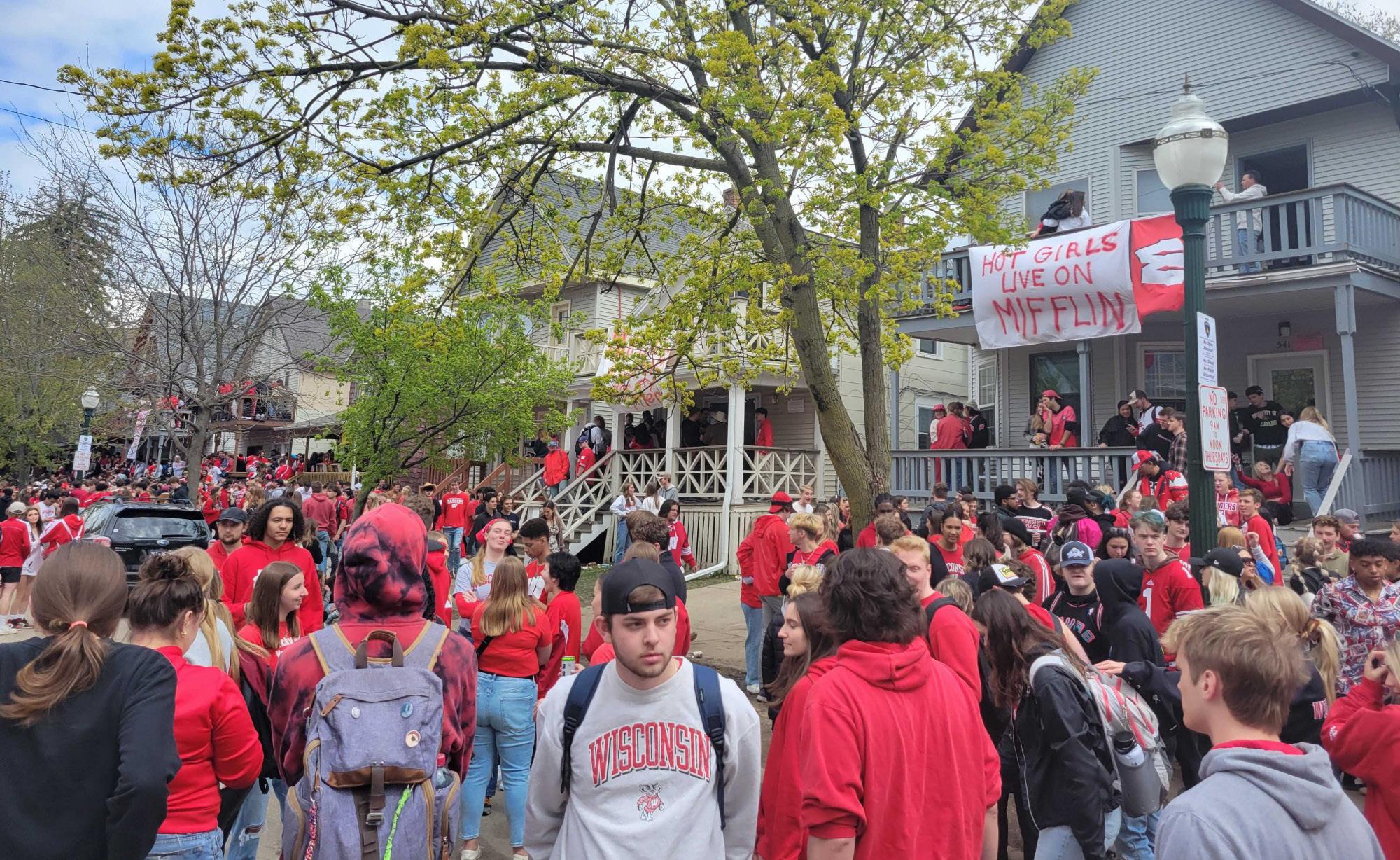
likely release another statement threatening its end after this year’s Mifflin once again. However, gradually phasing out the event would be detrimental to the culture of the university, and it could hurt the city itself. In 2023, there was an almost $2,000 increase from March to April in alcohol purchases. With the immense amount of food and alcohol potential partygoers buy, the event generates a considerable amount of revenue for Madison and its local businesses.
“During Mifflin last year, I had friends come that stayed in hotels, and we went to local restaurants and bars during the rest of the weekend,” said UW-Madison
sophomore Chloe Mitzner. “I’m from Colorado, so I can only imagine how many people come from nearby areas and do the same.”
Stripping the city of one of its biggest weekends for visitors could not only be a major disappointment for students, but for business owners as well.
While its continuation is not without controversy, Mifflin is important to the culture of the university and to Madison itself. The event fosters a sense of community within the student body and allows people from all over campus to come together and celebrate the community in a way that nothing else during the year truly does.
GenerativeAIisn’tgoinganywhere.Collegesneedtolearnhowtoworkwithit,notagainstit.
Lillie Sunby STAFF WRITERGenerative artificial intelligence technologies such as ChatGPT have exploded on college campuses. And after a year of grappling with the impact of these technologies on education, the true solution may not be one we expect: using ChatGPT not as a cheat code but as a tool for learning could be the key for AI integration into our academic lives.
As the semester comes to an end, it’s important to reflect on the accomplishments and challenges of the past school year. One of this year’s challenges was the integration and development of AI technology into our lives as college students. We all witnessed the rapid rise of various AI technologies, the most popular of which is ChatGPT with over 100 million monthly users by early 2023. However, with AI’s increasing popularity comes concerns from professors and campus leaders.
Before college, I had no idea what ChatGPT was. I had no idea how it could be significant in the academic world. My introduction to AI came after skimming through my syllabi and discovering new sections titled “AI Statement” or “Usage of Artificial Intelligence.” At first, I overlooked these sections, but my professors and TAs made sure that I understood the importance of AI in our courses.
During my first week of school, discussions about AI’s impact filled lecture halls. My professors went over ChatGPT’s tools, from answering ques-
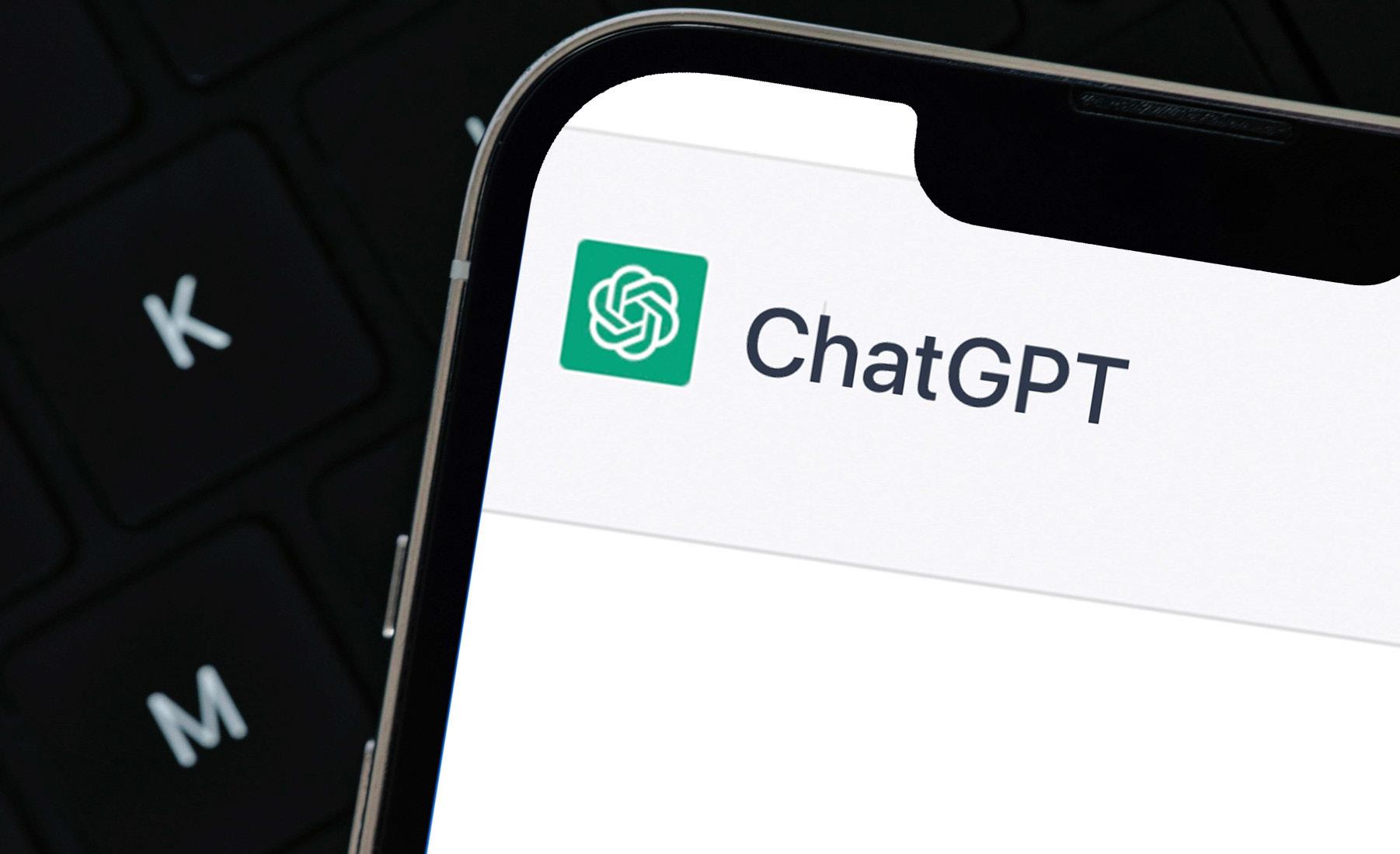
tions to handling complex calculations and even generating complete essays. These lectures were supposed to be heeded as a warning, but without realizing it, my professors had given an endorsement of ChatGPT to hundreds of students. By telling us all the tools that ChatGPT has, they made more students aware of its benefits.
According to a survey conducted by Intelligent.com, almost one in three college students have used ChatGPT for assignments. UW-Madison and its professors are aware students take advantage of this technology. But what is the best way for professors to engage with it?
Several professors choose to push
back against AI use through AI identification tools like TurnItIn. But there are still some concerns regarding these systems, which can sometimes mislabel student work as AI-generated.
Without a concrete way of knowing whether a student’s work is AI-generated, many professors are taking a di erent approach.
Several of my classes have made an e ort to incorporate ChatGPT into their curriculums. This kind of technology is not going away, so it may be best to embrace it as an academic tool. Comparing AI-generated text to human-generated text or using AI to encourage classroom discussion are just
a few ways professors could utilize this technology. By building this technology directly into assignments, professors can prevent ChatGPT as a means of academic misconduct and instead see it as a learning device.
In this way, professors show students that while ChatGPT and similar AI platforms can help with simple tasks, they cannot replace the human mind. My professors emphasized this concept throughout the year and encouraged my classes to use AI as a supportive tool rather than relying on it for full responses.
As we step away from our first year of classes with AI technology, there are some things we should keep in mind.
First, according to a study conducted by the Pew Research Center, two-thirds of U.S. teens said they have heard of ChatGPT, meaning more students are coming into college with an understanding of ChatGPT and its abilities. Given this, it is the university’s responsibility to introduce AI in a healthy manner so we can all gain a better understanding of how this technology works and how it a ects our academic lives. Professors and faculty will play a critical role in introducing students to this technology in the future, so how they frame AI technology will a ect how many students choose to use it.
By having educators take the time to explain AI concepts, address common misconceptions and teach responsible AI use, it has the potential to become a great learning tool in the future.
Hepburn, Storr’s departures all too familiar sight in today’s NILdriven college basketball climateBy Jacob Szczap STAFF WRITER
If you needed any reminders of the fast-paced and inconsistent nature of today’s college basketball climate, look no further than the Wisconsin Badgers’ tribulating o season.
Seven players have entered the transfer portal since Wisocnsin’s season came to a close in mid-March. After a season that peaked with a No. 6 ranking in the AP Poll and ended with an abrupt first-round exit in the NCAA Tournament, head coach Greg Gard and Wisconsin now face the uncomfortable reality of a rapidly evolving sport where money is king.
In a sport overtaken by the transfer portal and name, image and likeness (NIL) deals, this short oseason has sounded heavy alarms. Beginning with promising reserve Connor Essegian’s departure, headlined by star guard AJ Storr’s transfer and culminating with three-year starter Chucky Hepburn’s confounding exit, Wisconsin has been hit as hard as any program this portal season.
Along with the big names, Wisconsin has also lost a plethora of bench players, including Isaac Lindsay, Luke Haertle, Ross Candelino and the once heralded Gus Yalden, a former 4-star recruit, who never broke into Gard’s rotation.
This is a substantial turn for aWisconsin team that made solid strides at the beginning of this season. After missing out on the NCAA Tournament in the 2022-23 season, the Badgers regrouped, bringing in Storr via the transfer portal while relying on growth from other key pieces. It led to a 22-14 record, a trip to the Big Ten Tournament championship game and a 5-seed in the NCAA tournament, albeit with a disappointing, season-ending loss to James Madison.
But the result was seven players embracing the enticing arms of the transfer portal, illustrating how aggravatingly challenging it is to achieve sustained success in college basketball. Instead of running it back with most of a squad that made headlines in the Big Ten, Wisconsin will
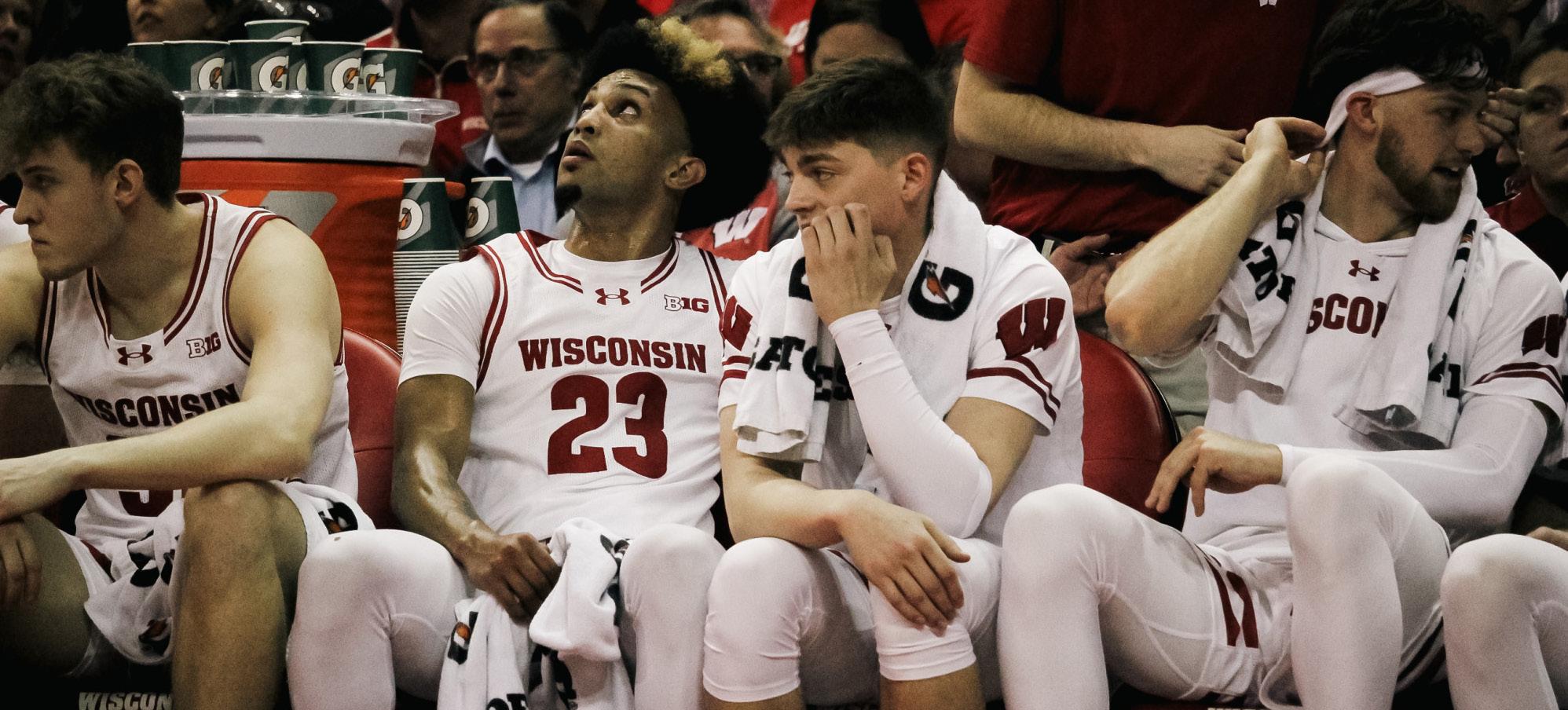
be forced to start anew next season. And yet in an age where transfer portal announcements have become painfully numbing, none of it seems entirely surprising.
Yearly significant roster turnover is the new norm in college basketball, and while it is unsatisfying and frustrating alike, it is here to stay.
Wisconsin’s tumultuous o season began when Essegian entered his name into the portal on March 24. Essegian, the sophomore shooting guard, struggled this season and experienced significant dips in playing time. A key contributor on the 2022-23 team, Essegian’s reduced role led to an unsurprising transfer at the end of the season. Essegian’s departure fit the mold of a modernage traditional transfer — a player unhappy with playing time leaving to seek greater opportunities.
Then came Storr’s announcement. Storr is a premier guard in college basketball, averaging 16.8 points a game this past season and entering the national conversation after a brilliant Big Ten Tournament run. His undeniable athleticism was rare for a Wisconsin player, and by midseason, he emerged as the most talented player on the team.
But after Wisconsin’s season-
ending loss, rumors Storr would not return to the program were already swirling. After all, dating back to his high school days, Storr was on his seventh team in as many years. Another move would shock no one.
Sure enough, on March 24, Storr declared his intentions to enter the NBA Draft. But on March 28, he switched course, entered the transfer portal and committed to Kansas on Thursday.
Then came the ultimate blow: Hepburn’s exit. The fan favorite announced his decision to hit the transfer portal Thursday, citing an “opportunity to explore new possibilities.”
If the Essegian and Storr transfers were disappointing to Badger fans, Hepburn’s decision was the final gut punch. Hepburn burst onto the scene as a freshman in the 2021-22 season and started all 103 games he played for the Badgers. Throughout his three seasons in Madison, fans watched him develop and mature into a consistently valuable player. Hepburn was destined to take the reins as team leader next year.
And all signs pointed to him returning. After the James Madison loss, a visibly disap-
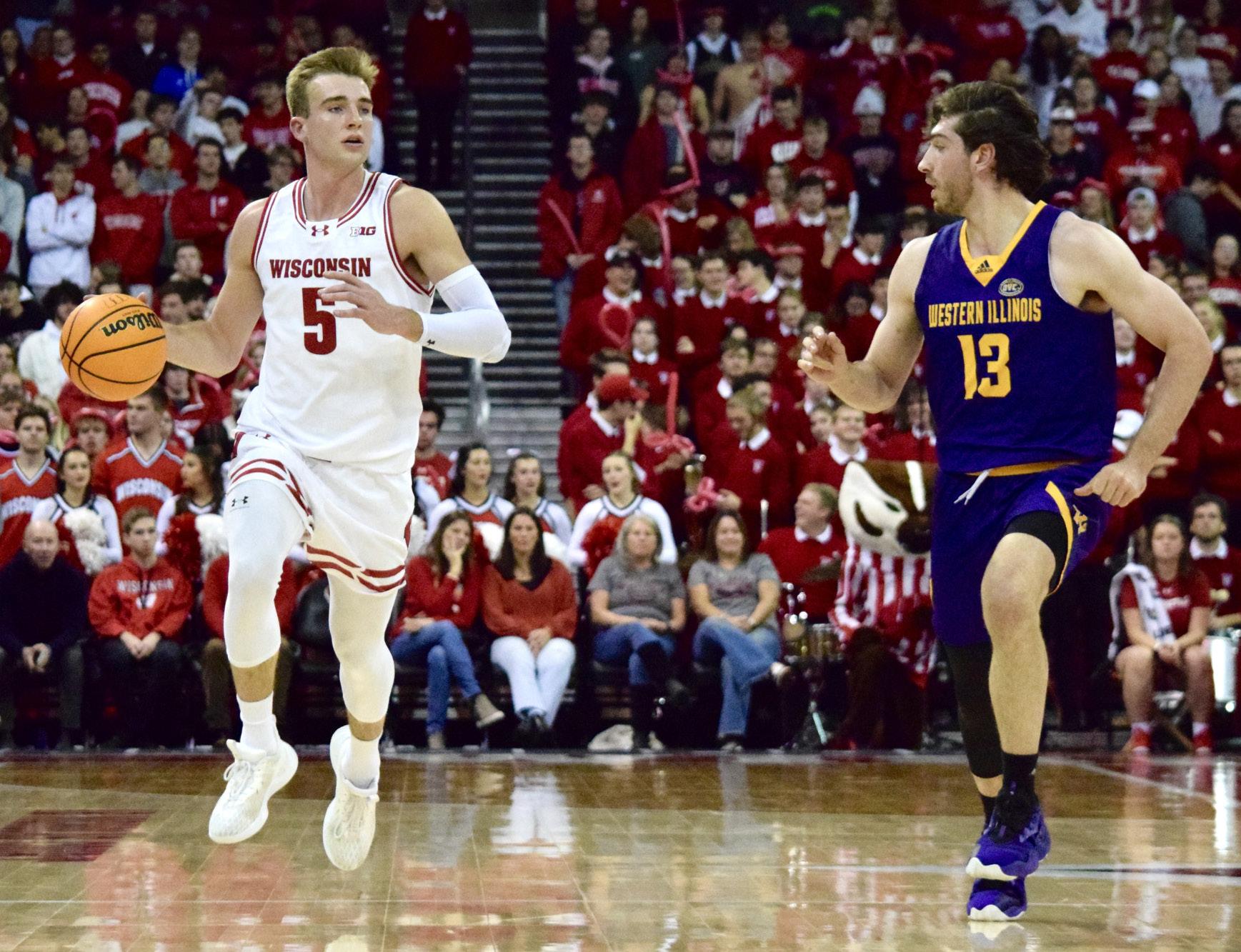
pointed Hepburn expressed a desire to finish strong as a Badger.
“We’re going to get back to this. This isn’t the last of us,” he warned. When asked if it was safe to assume he would be back next season, Hepburn replied with an immediate “yeah.”
Hepburn had been a classic Badger, growing in each season, becoming a recognizable face and a breath of fresh air in the uncertain era of the portal. He consistently spoke of taking pride in wearing a Wisconsin jersey and even had a badger tattooed onto his arm.
All of this makes his transfer an alarming eye-opener. If a player like Hepburn could hit the road, anyone could.
It should be said that Hepburn’s departure was not with backstabbing nor disloyal intentions. In his departing message, Hepburn said his decision was “not a reflection of anything lacking at Wisconsin.” He was a player who unquestionably cared about Wisconsin. The emotion in his voice and tears streaming down his face as he spoke of what it meant to be a Badger after the James Madison loss speaks for itself.
Rather, it’s a message, and a clear
one at that, of the incredible opportunities and challenging decisions that college athletes are presented with today. Unlimited transfers and legalized NIL payments have opened the door to waters past players never had to navigate through.
While financial reasons are not the confirmed reason for Hepburn’s departure, it certainly is a possibility. If so, he should not be faulted for taking up a possibly once-in-a-lifetime opportunity to cash in.
But it can still be said that constant maneuvering via the transfer portal is an unorganized and maddening experience. Programs like Wisconsin can no longer expect to develop players in the way they once did. A player’s traditional four-year journey seems long gone.
Wisconsin must adapt, and the dramatic outflow of players from the program provides a stark signal.
So while the transfers Storr and Hepbrun sting, this is the doubleedged nature of college basketball today. In an evolving landscape, players fairly use their right to search for opportunity, while programs are left unrecognizable.
After this week, no one knows this harsh, uncomfortable reality better than Wisconsin.
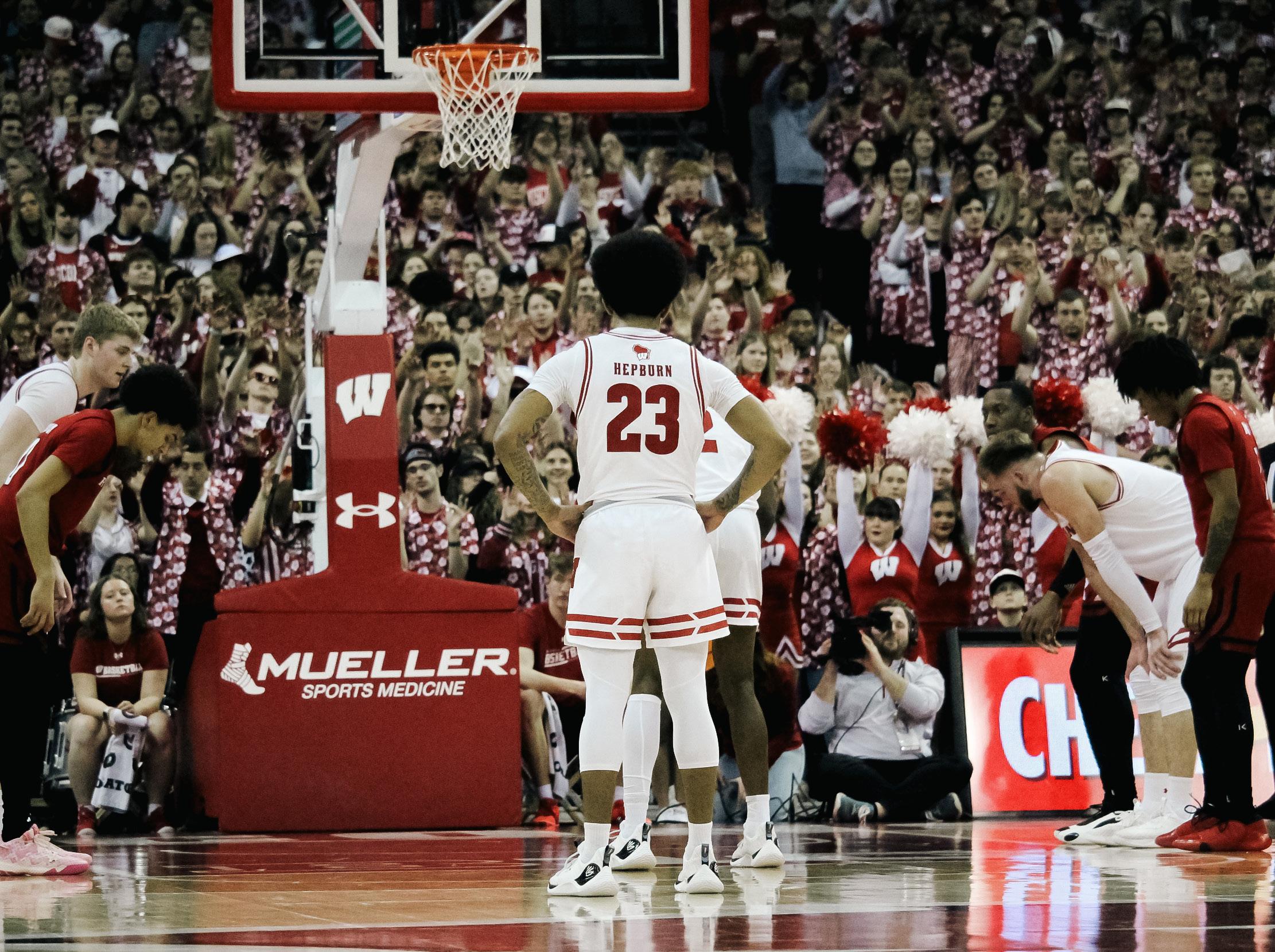
University of WisconsinMadison scientists at the Wisconsin Energy Institute discovered a more sustainable way to produce Tylenol and other household painkillers.
Scientists Steven Karlen and Vitaliy Tymokhin identified an environmentally friendly method to create paracetamol, a key component of painkillers like Tylenol, UW-Madison’s Wisconsin Energy Institute announced earlier this month.
Tylenol is traditionally derived from crude oil and petroleum, which can be damaging to the environment. Now, the painkiller has a greener alternative researchers source by extracting and converting lignin, a plant compound with a similar molecular structure.
What is the painkiller material?
Paracetamol, also known as acetaminophen, has long been a global go-to for temporary fever relief since the 1900s, according to the National Institutes of Health. However, its traditional manufacturing from coal tar or petroleum derivatives has posed environmental concerns, leading to widespread accumulation in water sources worldwide.
In 2019, a team led by
UW-Madison biochemistry professor John Ralph and Steven Karlen, a staff scientist at the Great Lakes Bioenergy Research Center at that time, found paracetamol could be obtained from a compound naturally occurring in poplar trees: p-hydroxybenzoate (pHB), found within lignin, a crucial component of plant cell walls.
The duo’s innovative method earned them a patent for synthesizing paracetamol from lignin, which serves as the backbone of certain plants.
However, converting pHB into paracetamol wasn’t ecient to start. While the initial breakthrough demonstrated the chemical feasibility of converting pHB into paracetamol, Karlen said in a press release the process didn’t e ciently convert enough raw material into the final product.
“Lignin is an extremely complex, messy polymer. No two molecules in a plant are exactly the same. It’s very e ective for providing structure and defense for the plant, but it’s challenging for us to break down into useable materials,” Ralph, the leader of research team said in an interview in 2019.
Since then, his team has been dedicated to enhancing the pro-
cess, aiming to make it more ecient and environmentally friendly.
This time around, researchers found pHB can be easily separated through chemical treatment. The process is primarily water-based, employs eco-friendly solvents and operates continuously rather than in batches, rendering it highly suitable for industrial applications.
“We did the R&D to scale it and make it realizable,” Karlen said.
Researchers achieved a 90% conversion rate of raw material into paracetamol by continuously recycling unreacted material in a reactor. Karlen said he anticipates further optimization could raise the yield to 99%.
It holds the potential to create new revenue streams by making cellulosic biofuels — biofuels derived from non-food plant fibers — more cost competitive with fossil fuels.
“You can make dyes like black ink, polymers which can be used in textiles or material application, convert it to adhesives or into stu like that,” Karlen said.
The research was published in the journal ChemSusChem.
What’s the economic impact of this discovery?
The process will open for commercial licensing through the Wisconsin Alumni Research
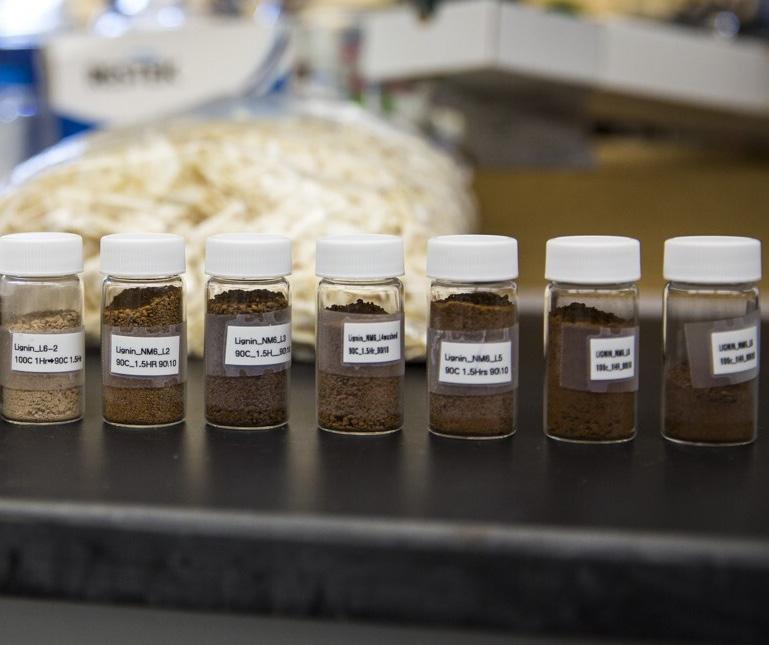
Foundation, the nonprofit organization that commercializes university discoveries to support ongoing research.
Paracetamol has an annual global market size of approximately $126 million within the trillion dollar pharmaceutical market, per data from Business Research Insights. Its demand spiked in recent years across all regions due to the COVID-19 pandemic, and in 2021, around 5.3 million prescriptions were issued for paracetamol.
“It’s got a huge market and big value,” Karlen said.
At the same time, Karlen’s team has enhanced the paracetamol production process along with other drugs, pigments, textiles and biodegradable plastics.
He said this diverse product portfolio could sustain numerous small biorefineries, which would feed into larger hubs without flooding the market.
“As I’m chopping the tree up, it can feed right into a reactor that pulls out the benzamide,” Karlen said. “So you’re never stopping. As fast as your trucks can come in and fill that hopper, you can keep processing.”
He’s turning 80 this year, but you probably still see him all around the country delivering one message: only you can prevent wildfires.
Be it on TV, radio or driving by one of the many standing fire danger signs, Smokey Bear has spread the message of wildfire prevention for decades. But statistics say there’s a lot more work to be done.
Since 1983, the National Interagency Fire Center reported an average of approximately 70,000 wildfires per year across the country.
Wildfires are natural parts of some ecosystems and can be beneficial to native plant species and biodiversity, according to National Geographic.
However, a significant number of those aren’t part of natural forest systems. Natural wildfires are most often caused by lightning, but in Wisconsin, 98% of wildfires are caused by humans, according to the Wisconsin Department of Natural Resources (DNR). That also means that 98% of wildfires in the state can be prevented.
Catherine Koele is a wildfire prevention specialist for
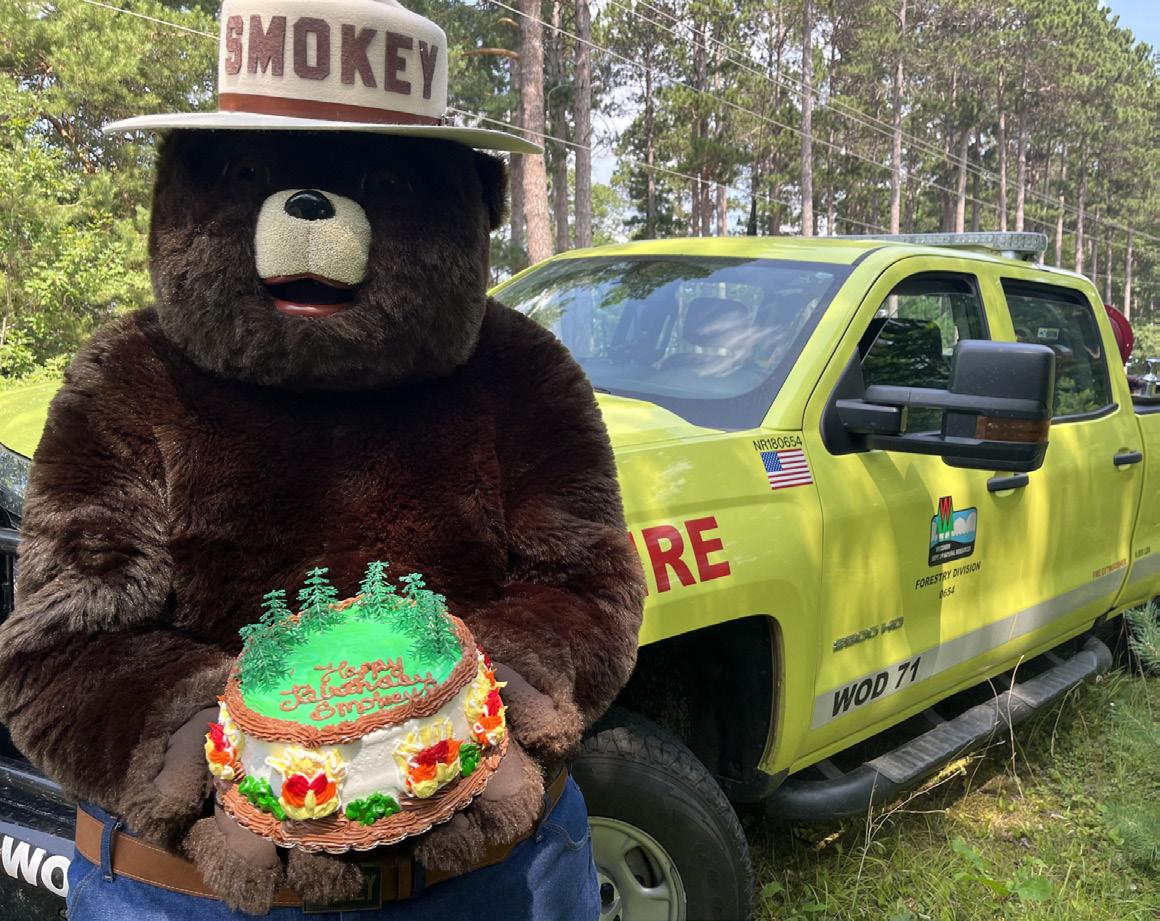
the Wisconsin DNR and has been doing the job for about 20 years.
“I think there’s a little bit of a misconception about kinds of fires in the Great Lakes region. You see the news and you think of these huge wildfires in the Western United States, but a lot of those are caused by lightning,” Koele told The Daily Cardinal. “In Wisconsin, about a third of our fires are caused by debris burning, so it’s kind of a cultural thing.”
Dane County has already seen four wildfires in 2024. Wisconsin as a whole has seen 508 wildfires and 1,006 acres burned so far this year, according to the DNR. From 2012 to 2023, the state lost 338 structures to wildfires, and 4,090 structures were saved from wildfires.
Koele said wildfires that start in remote areas out west are less likely to a ect property. But Wisconsin’s forests and where people choose to build homes poses a unique wildfire threat in the state.
“[In Wisconsin] our fires are very fast, very quick. They’re typically caused by people where people live, so it does place a higher risk on homes and properties,” Koele said. “It’s called a wildland urban interface. We do have a lot of
that where the forest meets homes. When these fires occur, it immediately places your home at risk.”
Beyond debris burning, which requires a permit, Koele said campfires and cooking fires can be dangerous if done recklessly.
“While we don’t have a ton of those wildfires in Wisconsin — less than 10% — a fire in the wrong place can do some damage,” Koele said.
Earlier this April, a cooking fire caused a wildfire that burned through 200 acres in Washburn County, Koele said.
What you can do to protect Wisconsin’s forests
As Wisconsin moves away from the spring and winter season into another summer, here’s what to keep in mind to protect the environment while enjoying the outdoors.
The major threats are organized fires like debris burning and cooking or campfires, Koele said. Fireworks also cause a concerning spike in wildfires, particularly around the Fourth of July.
“In Wisconsin, we have most of our vegetation pretty greened up usually in July, and that’s usually when we start to see fires go down,” Koele said. “But if we find ourselves in a drought situation, having
those fireworks — any sparks can cause a fire, especially in those really dry grasses.”
Be careful disposing of charcoal briquettes from the Fourth of July and summer grills, too, Koele said. If they’re still hot to the touch, they could be prime fuel for a wildfire.
Cigarette butts, despite their perceptions, aren’t among the leading causes of wildfires.
“Less than 1 or 2% of our fires are caused by smoking debris, so not to say that it can’t happen,” Koele said. “We shouldn’t be throwing any smoking materials into the outdoors just because of the littering obviously, but I think that’s a big misconception.”
The best thing you can do is educate yourself about wildfire risks and always check the local fire danger and fire restrictions before heading out to grill, start a campfire or recreate with any sort of fire, Koele said.
The WISBURN app also provides educational resources, Koele said. Smokey Bear also has fire safety tips on his website.
As you head out to enjoy Wisconsin’s beautiful outdoors, don’t forget to keep one of America’s favorite bears and his message close to your heart. It’s up to everyone to keep Wisconsin’s stunning forests safe from wildfires.
